
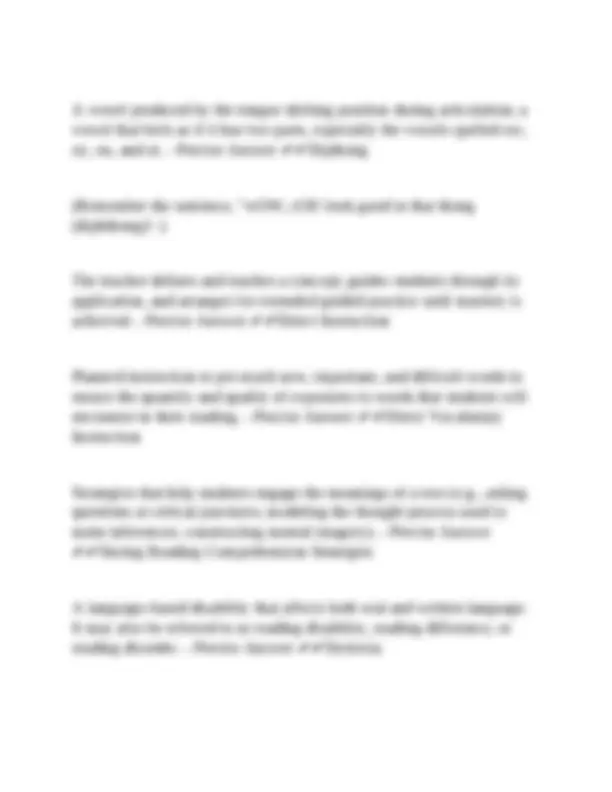
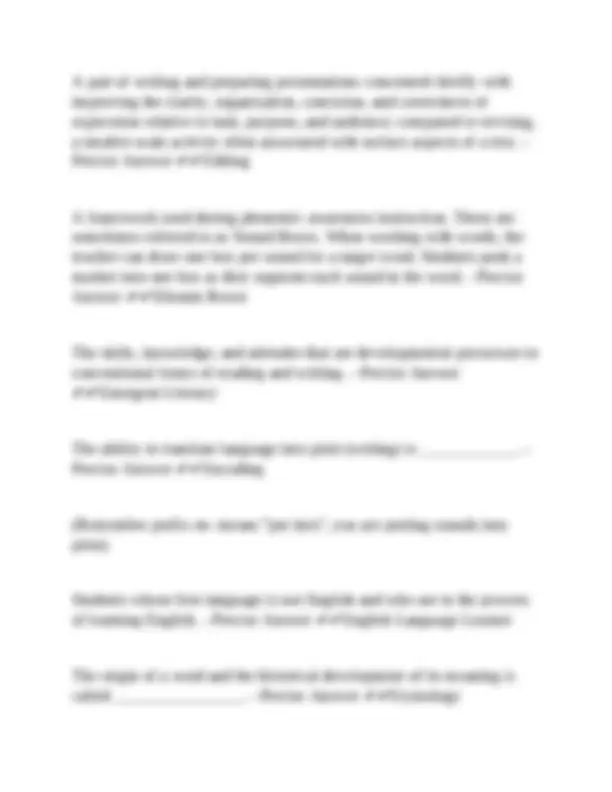
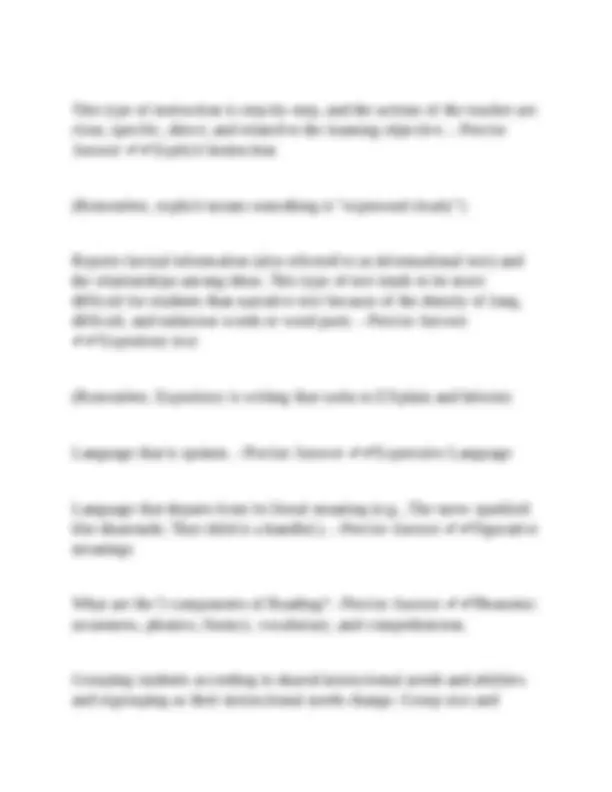
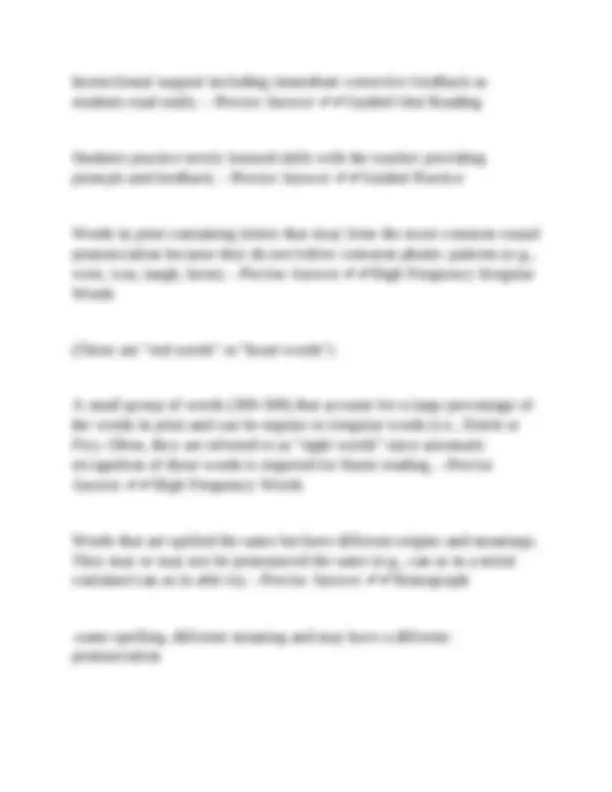
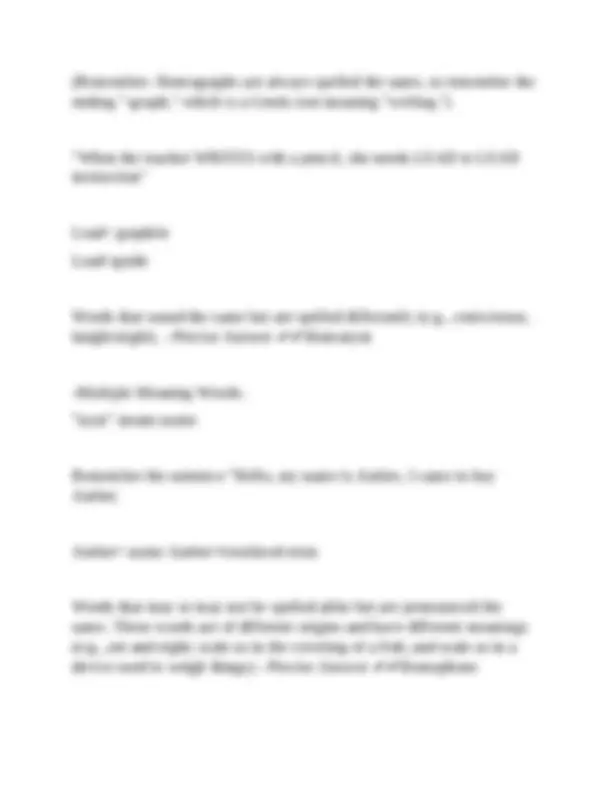
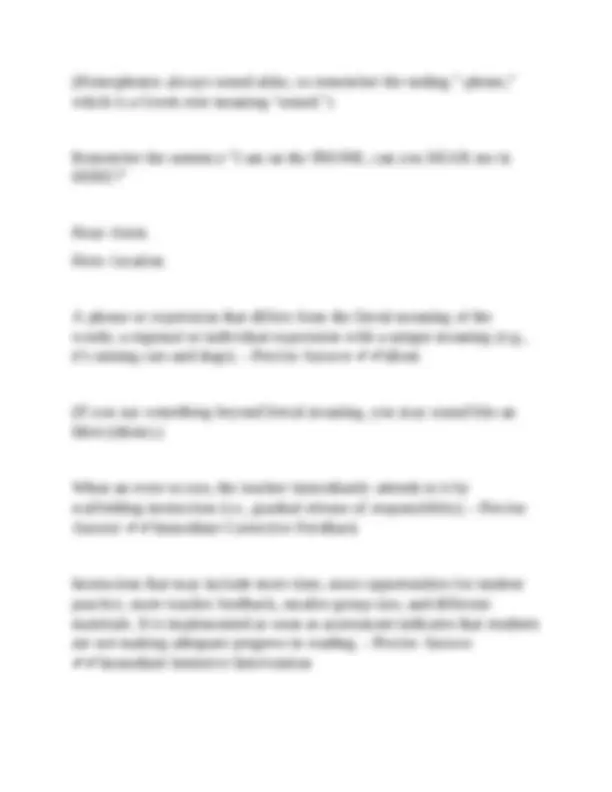
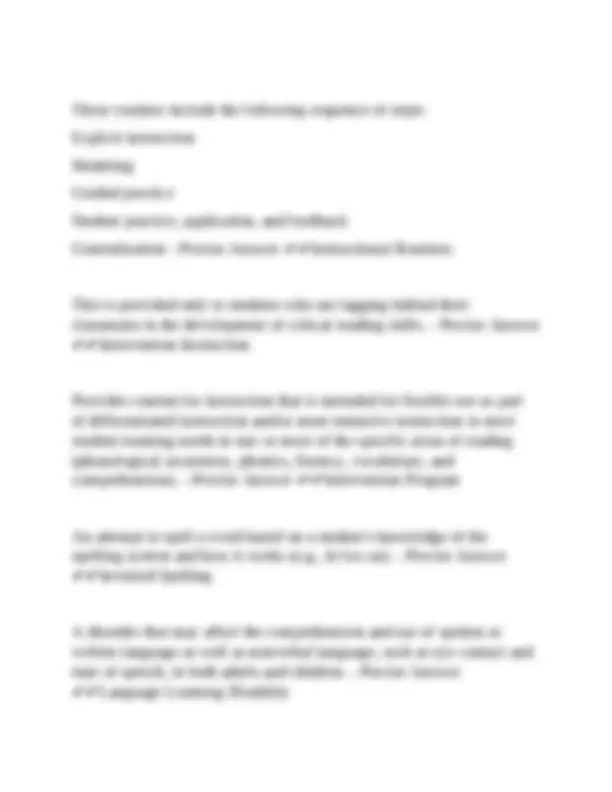
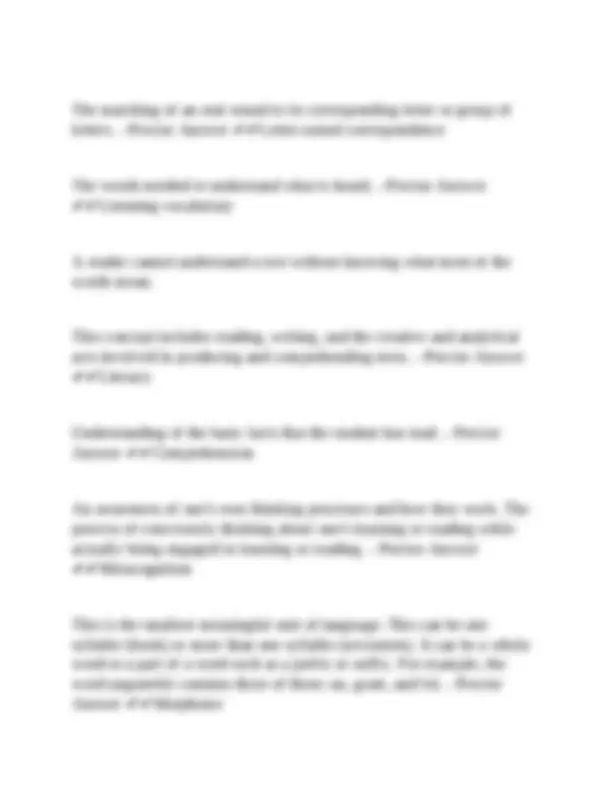
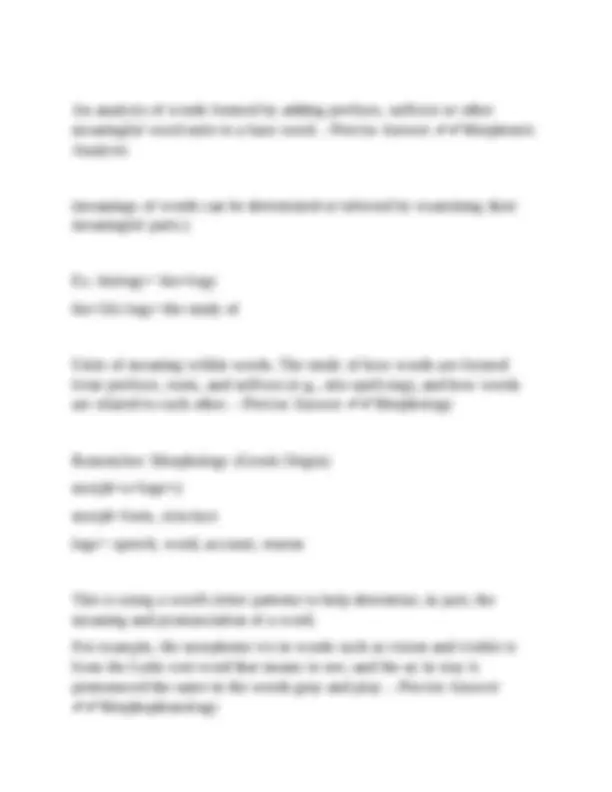
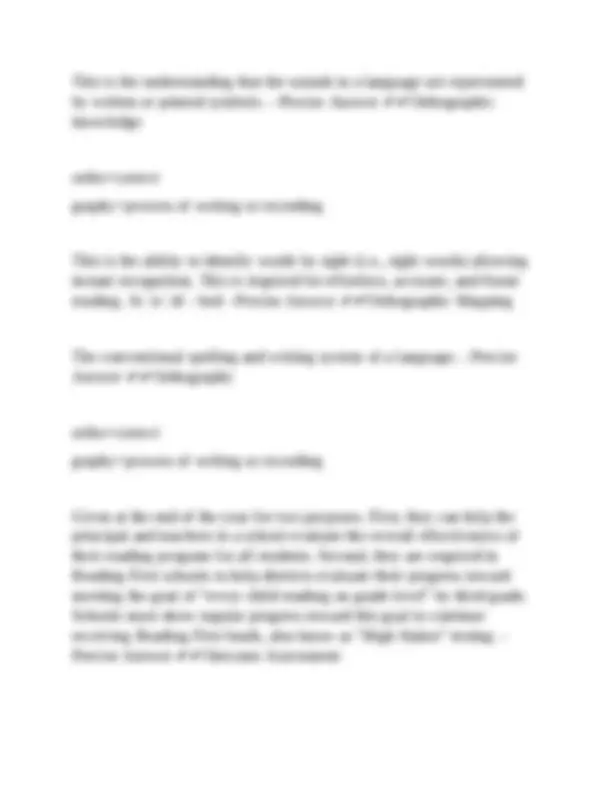
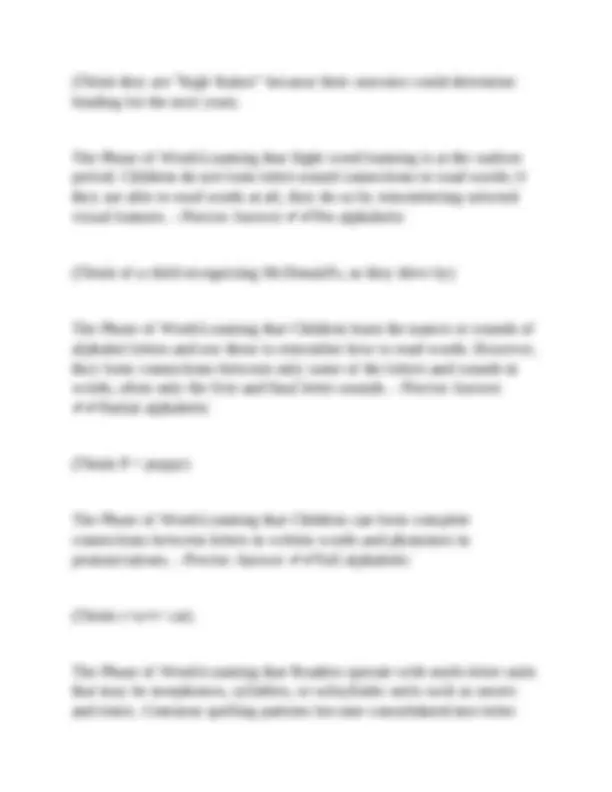
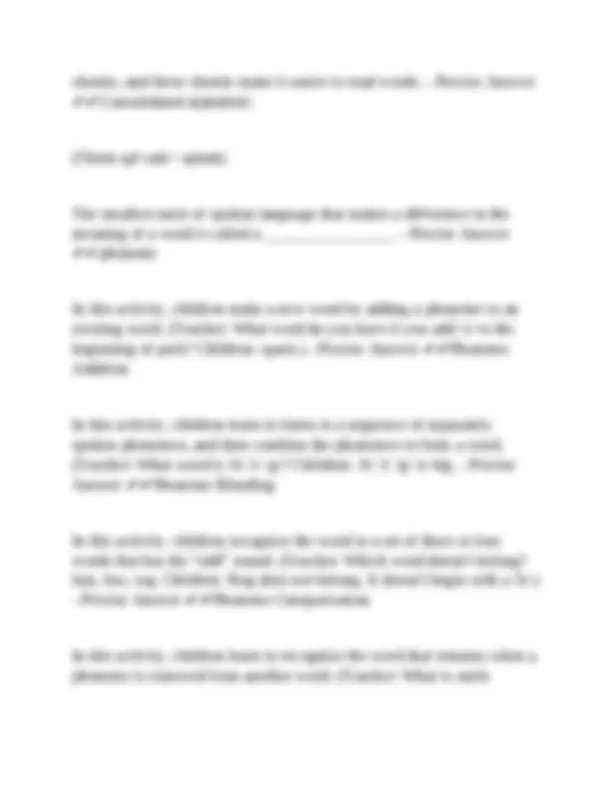
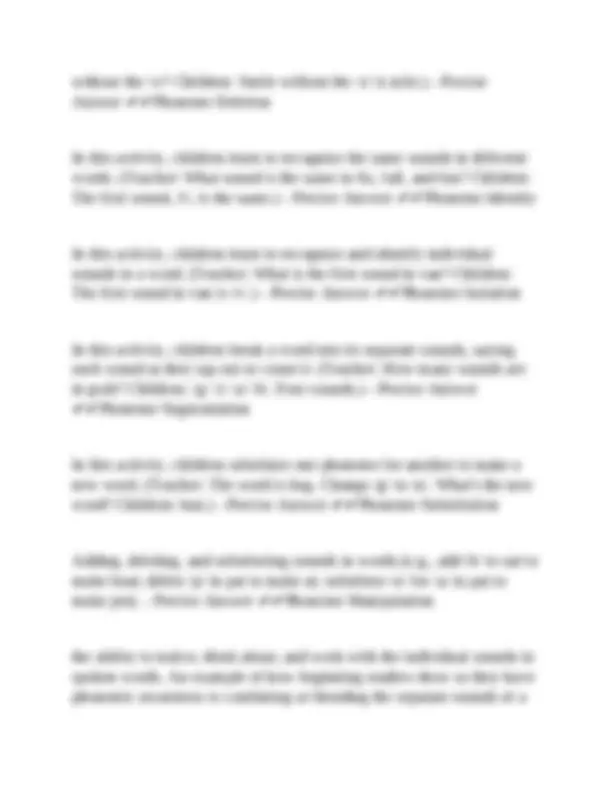
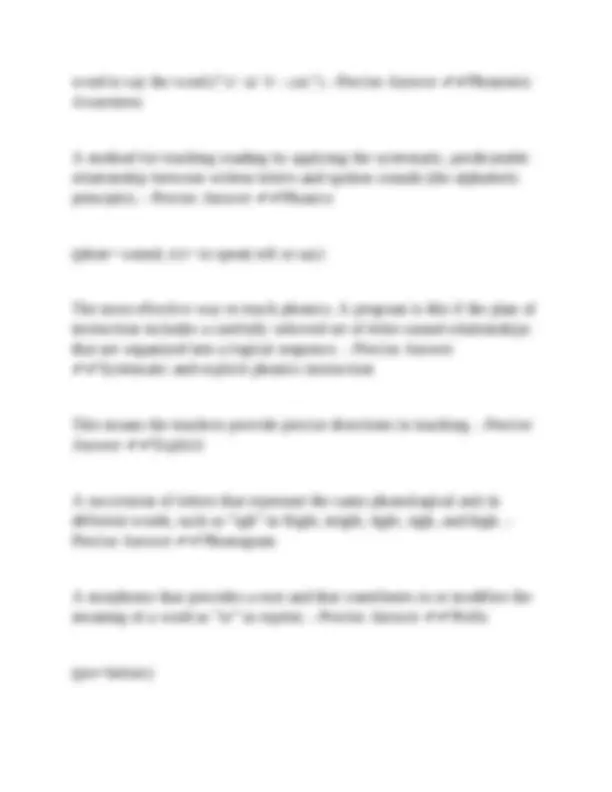
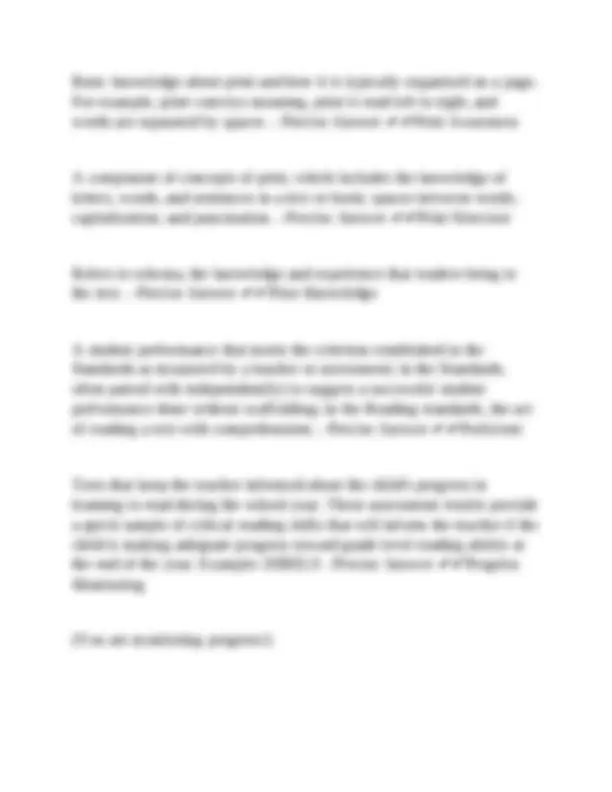
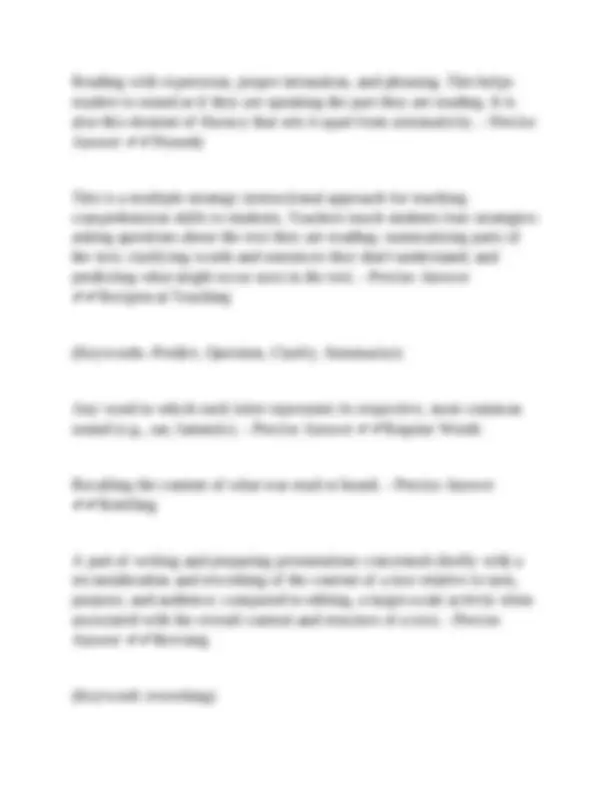
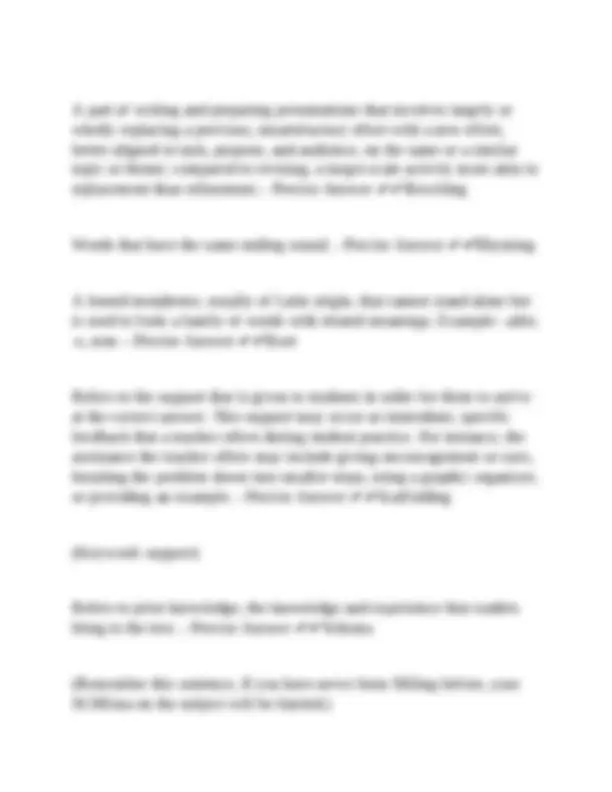
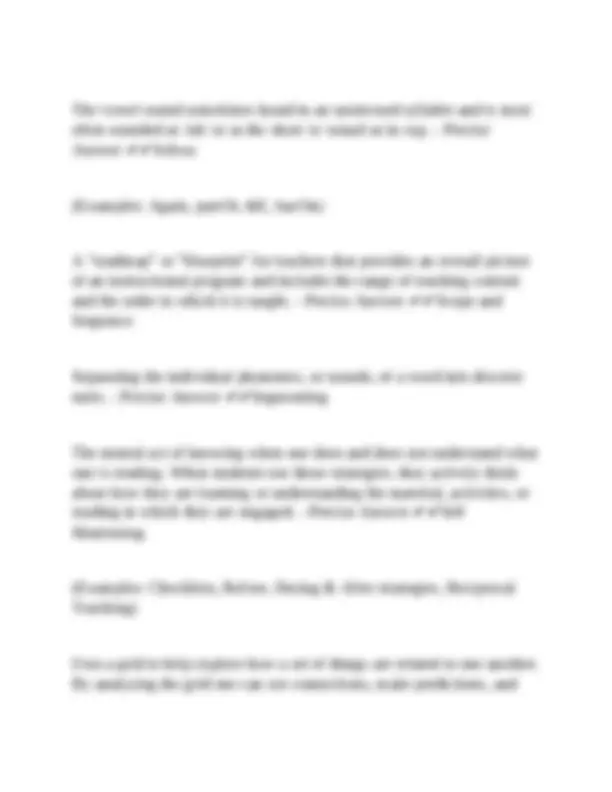
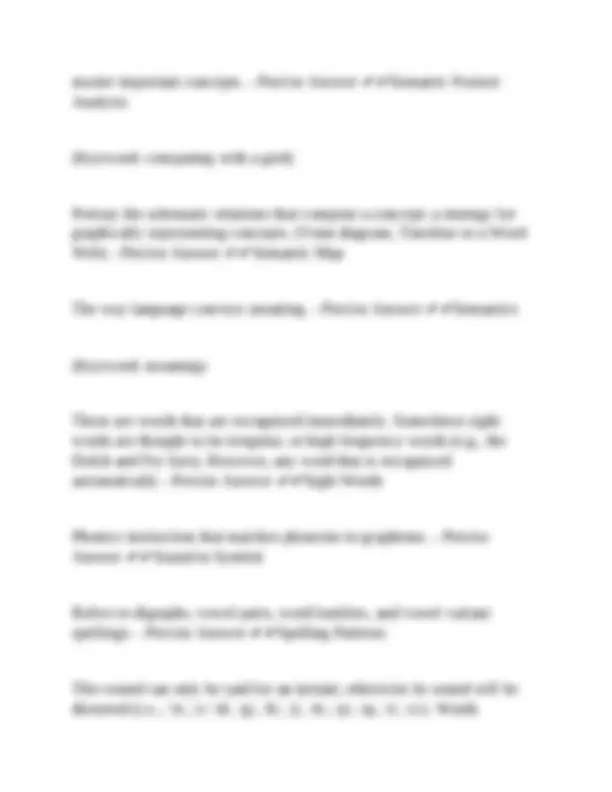
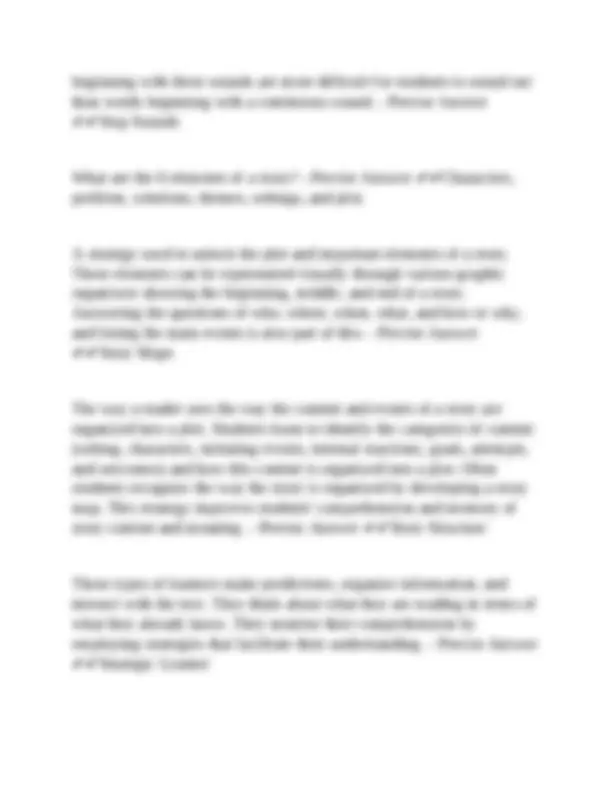
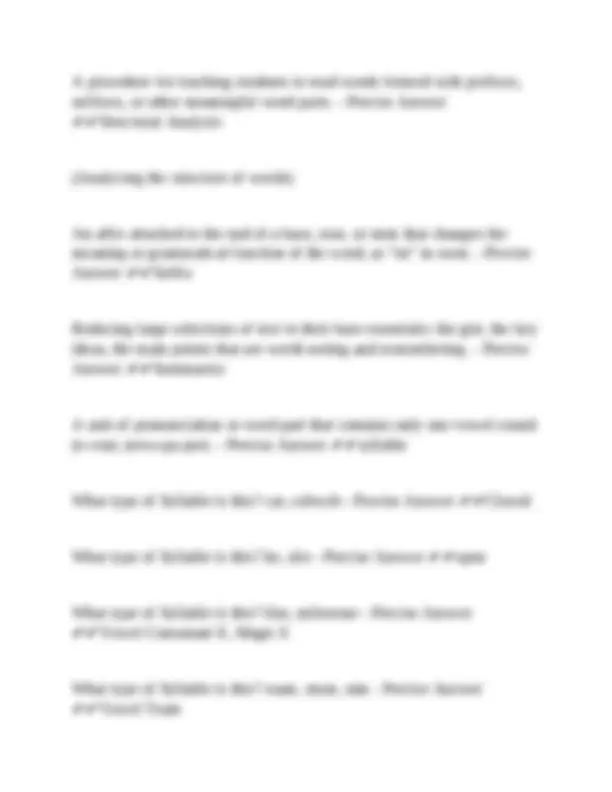
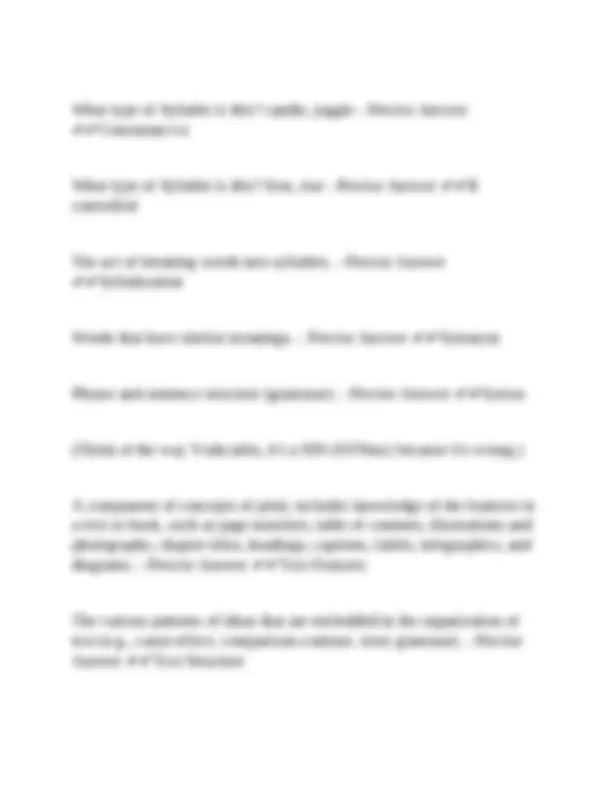
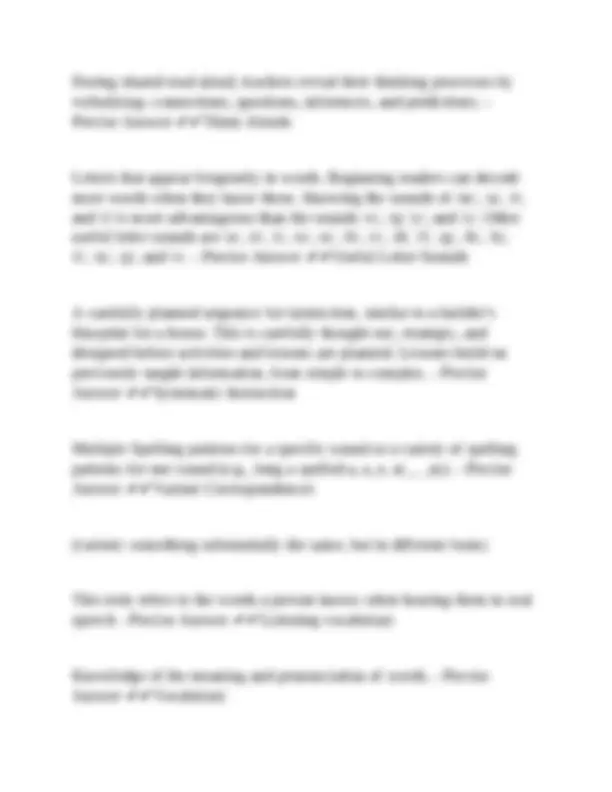
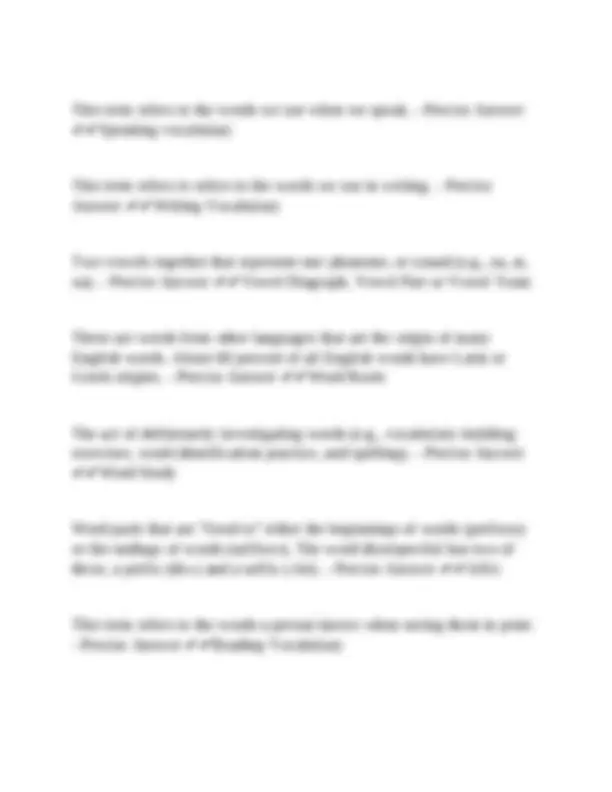
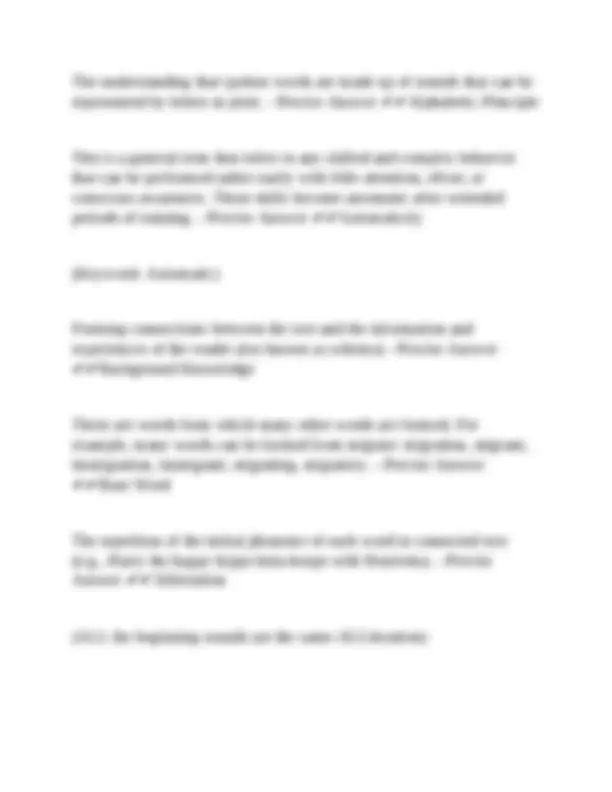
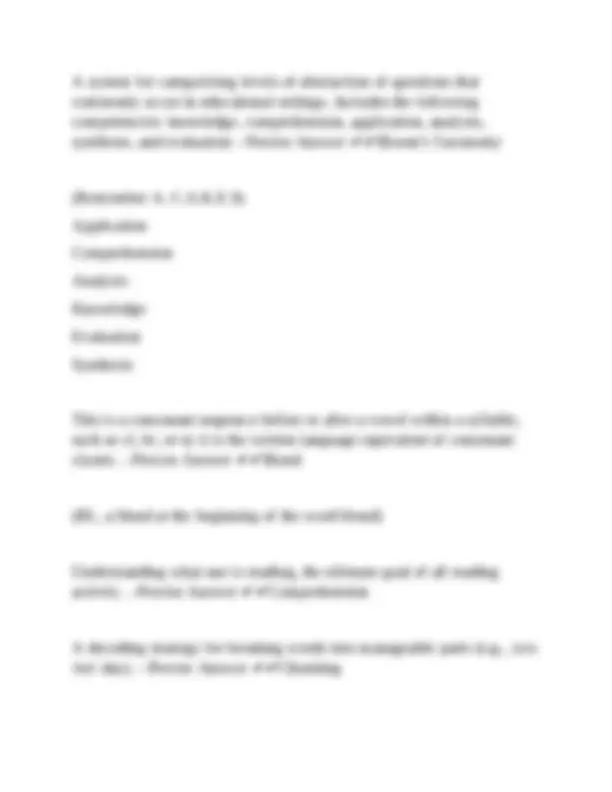

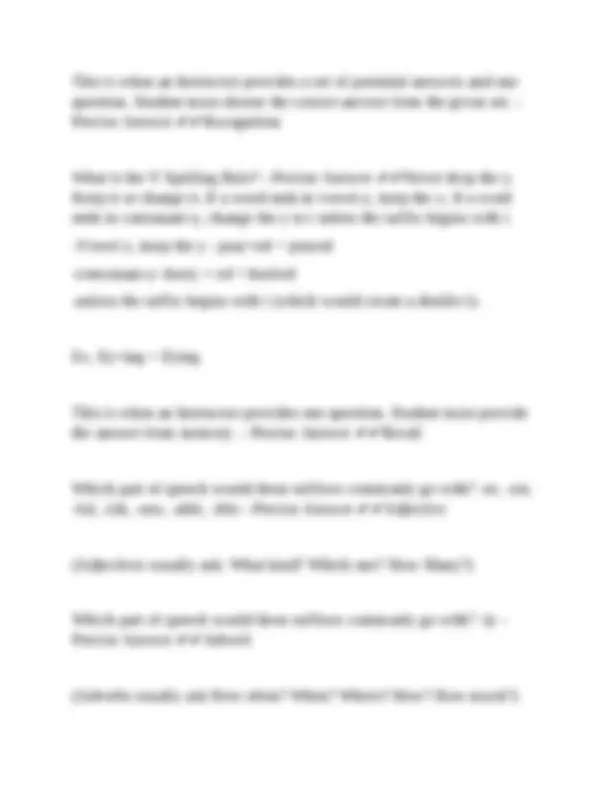
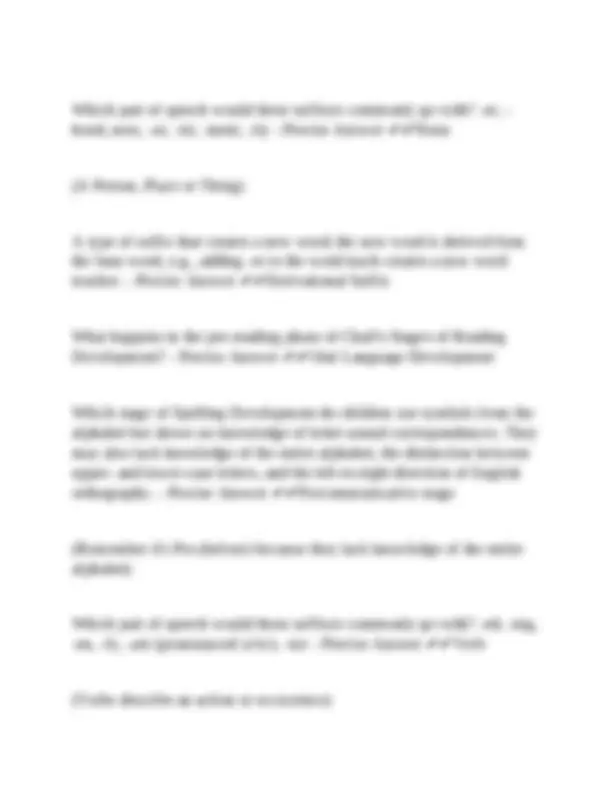
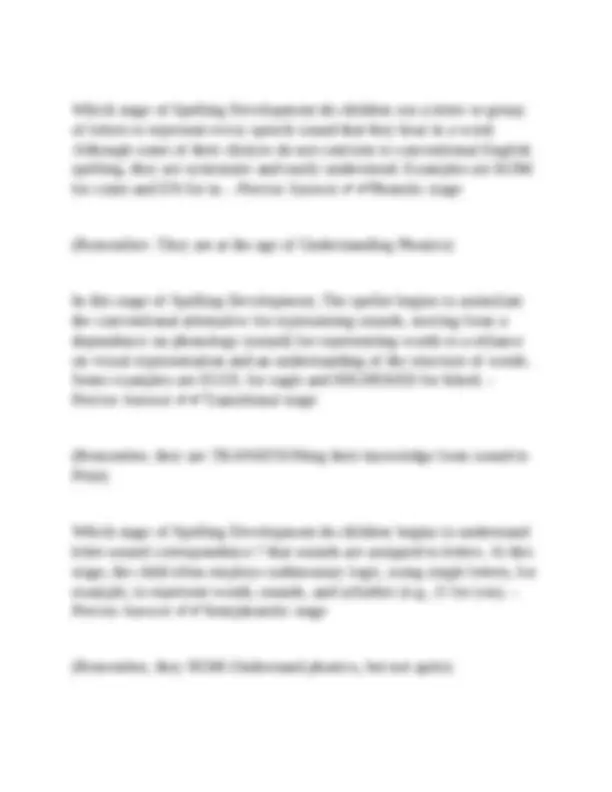
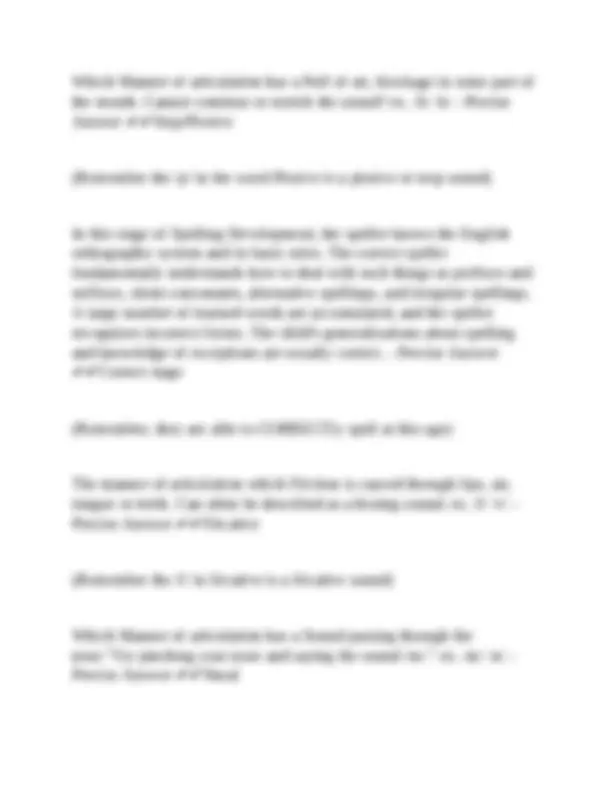
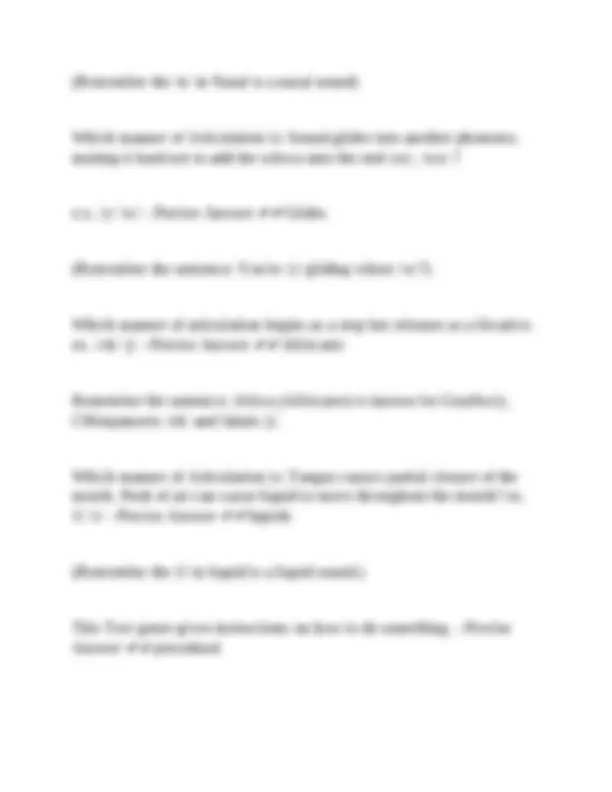
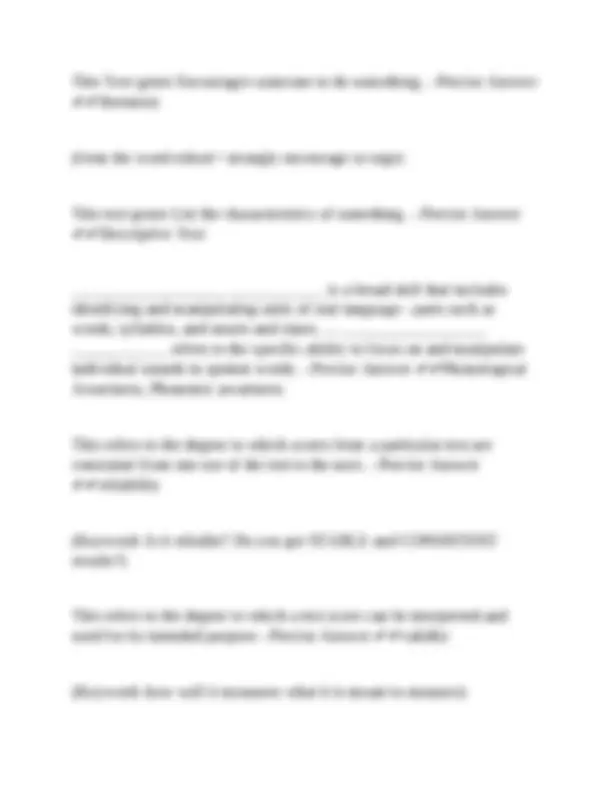
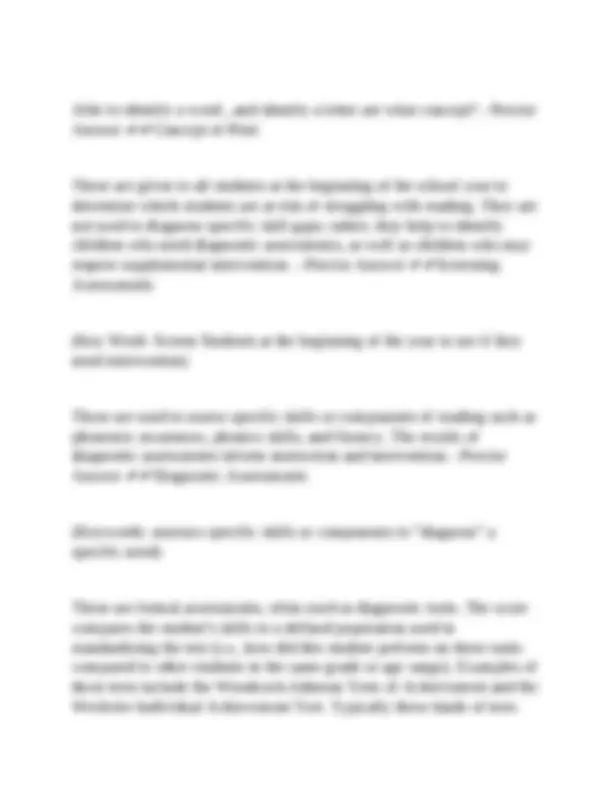
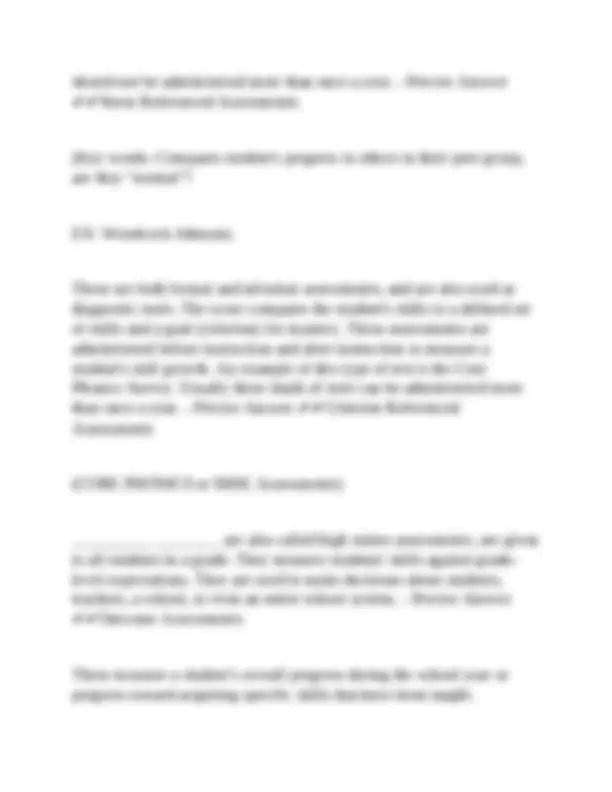
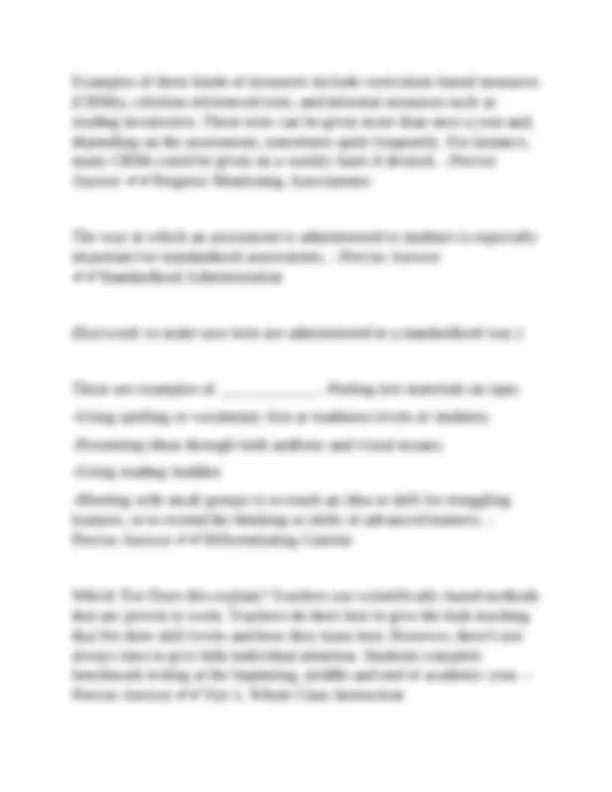
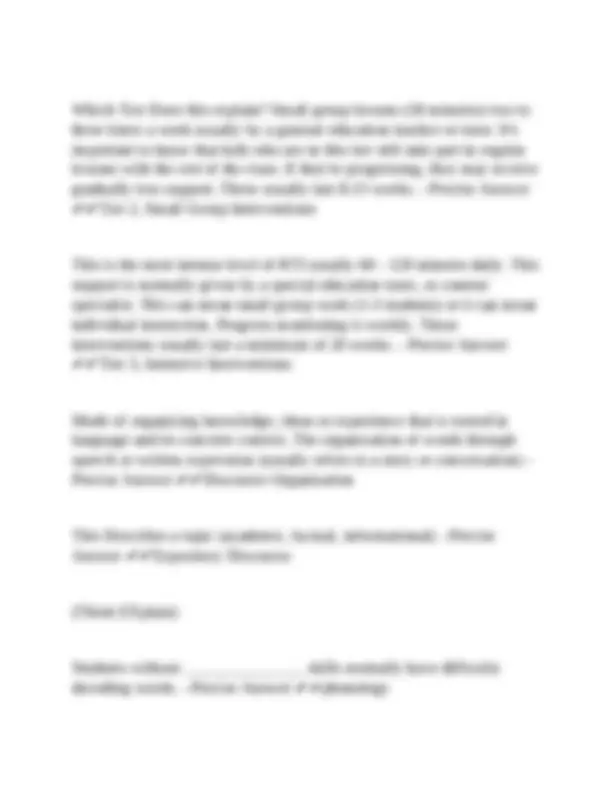
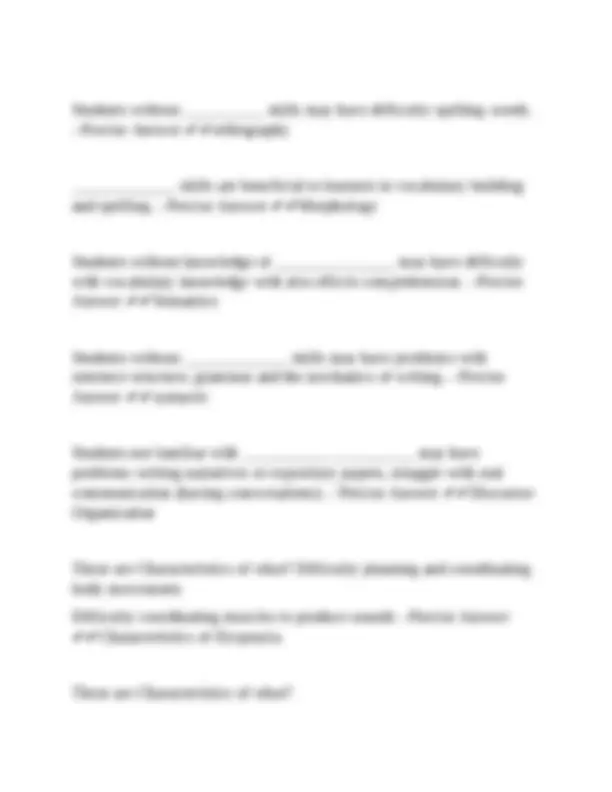
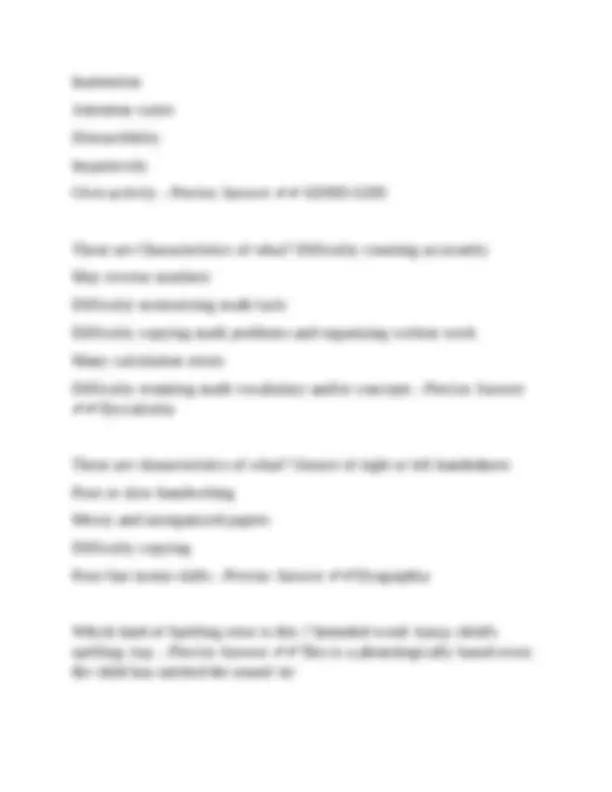
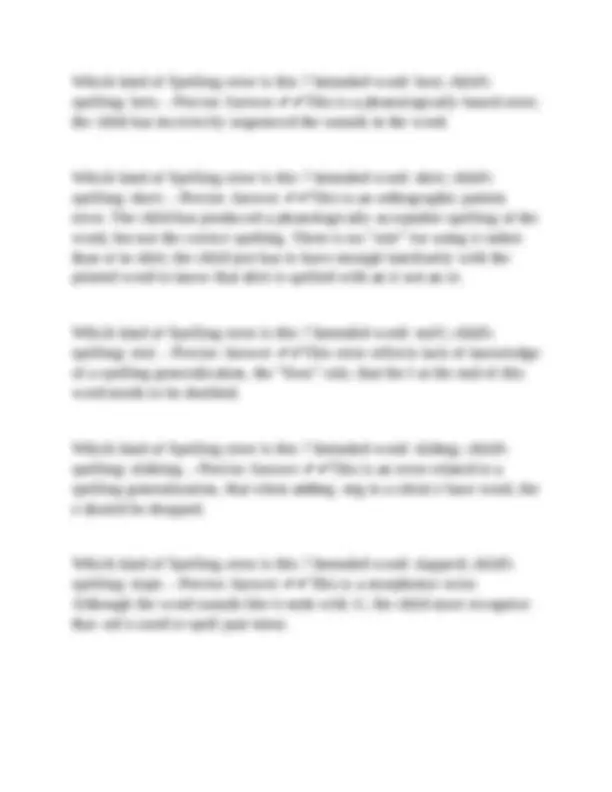
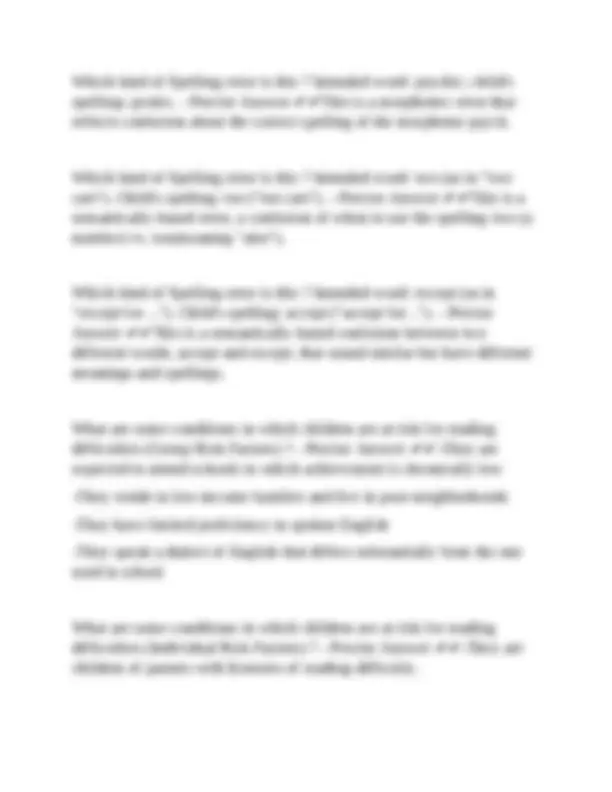
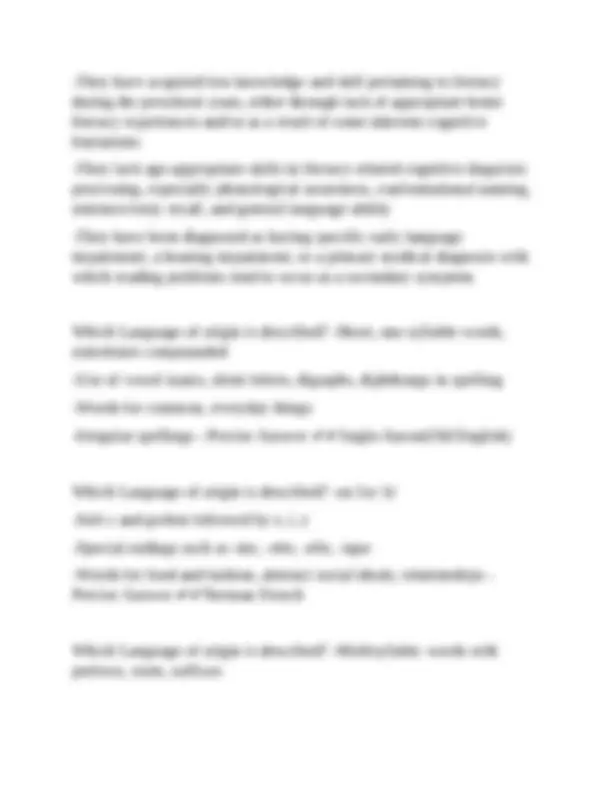
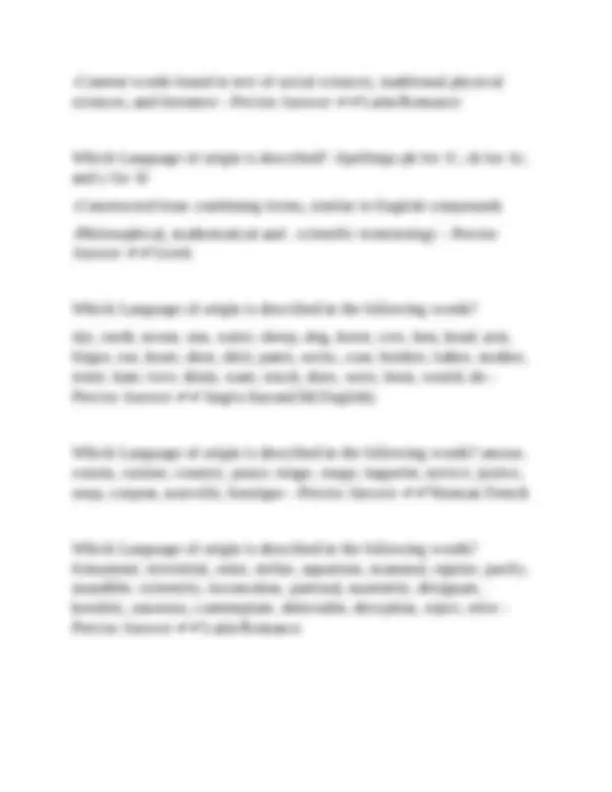
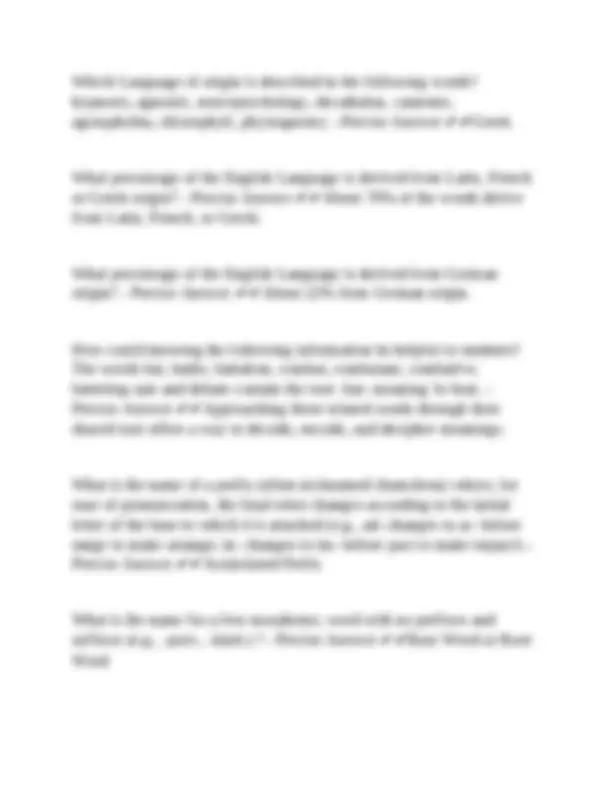
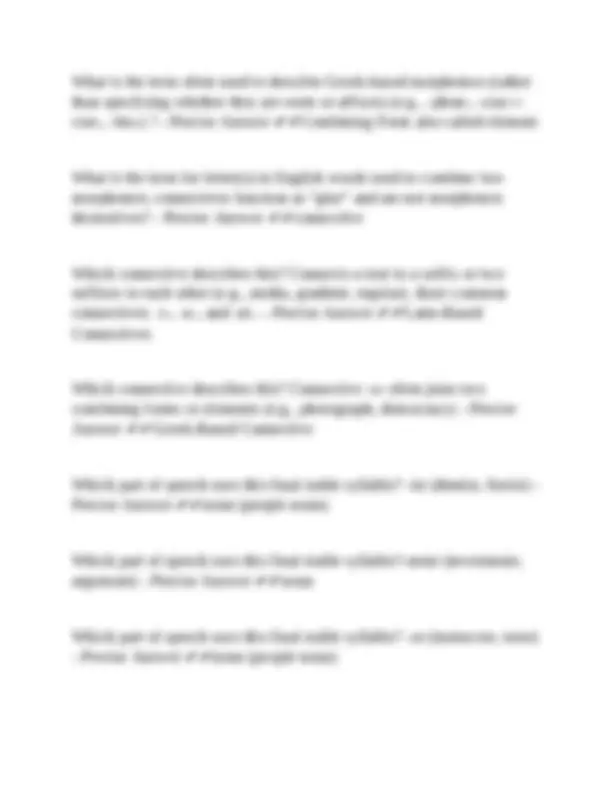
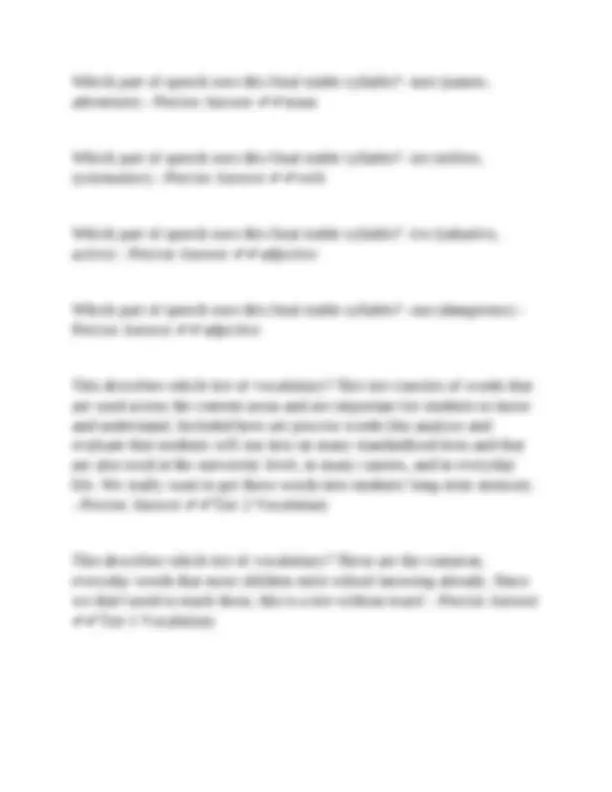
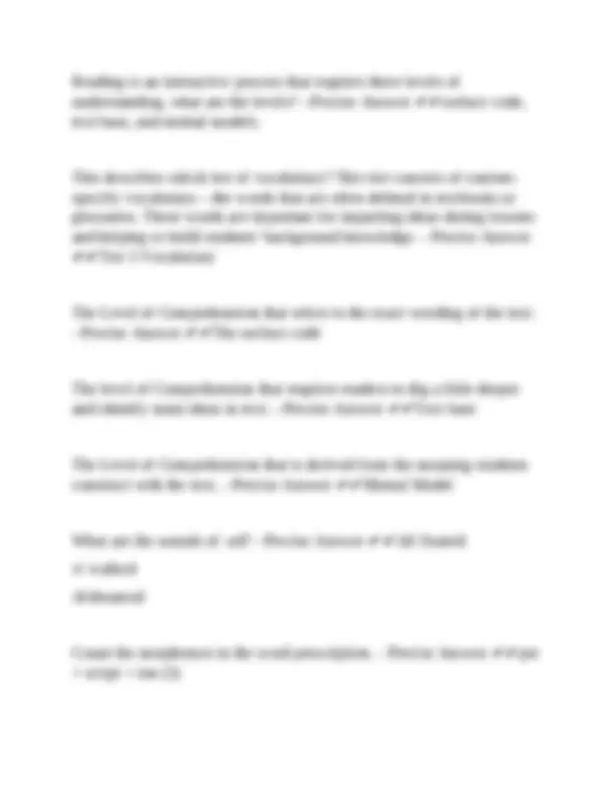
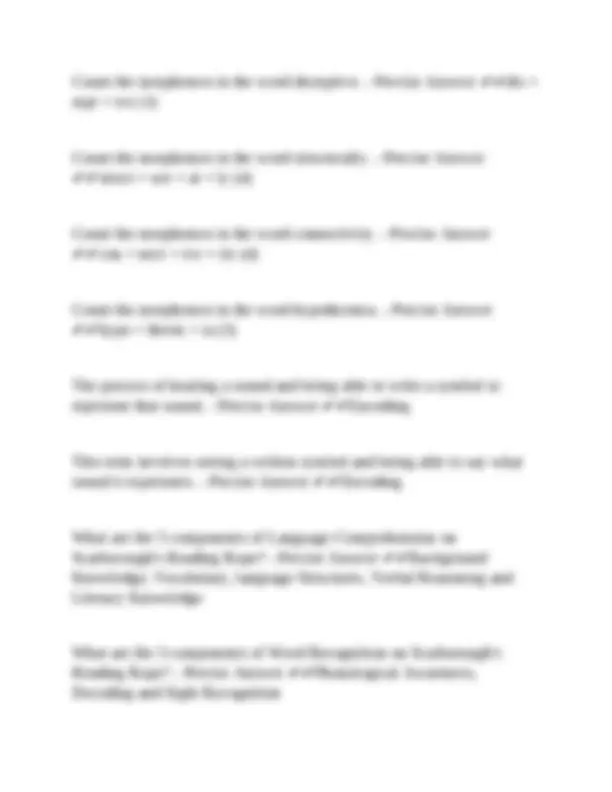
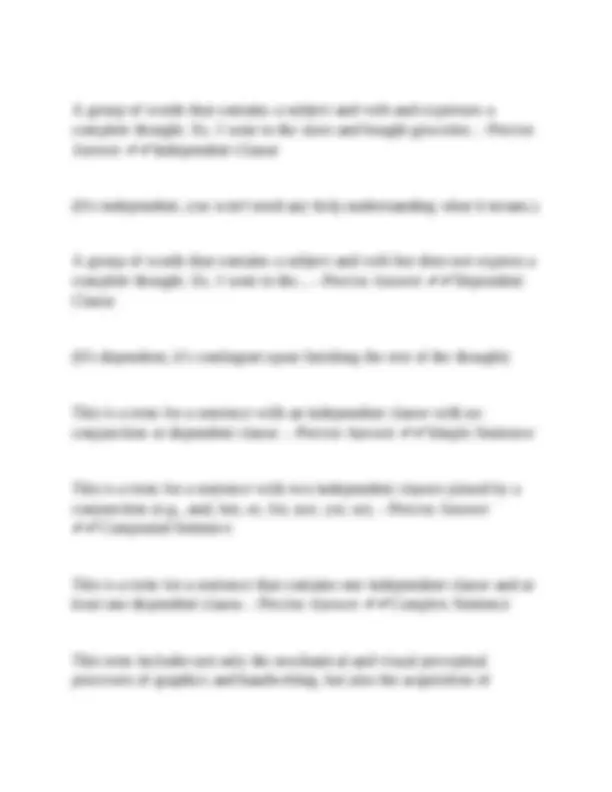
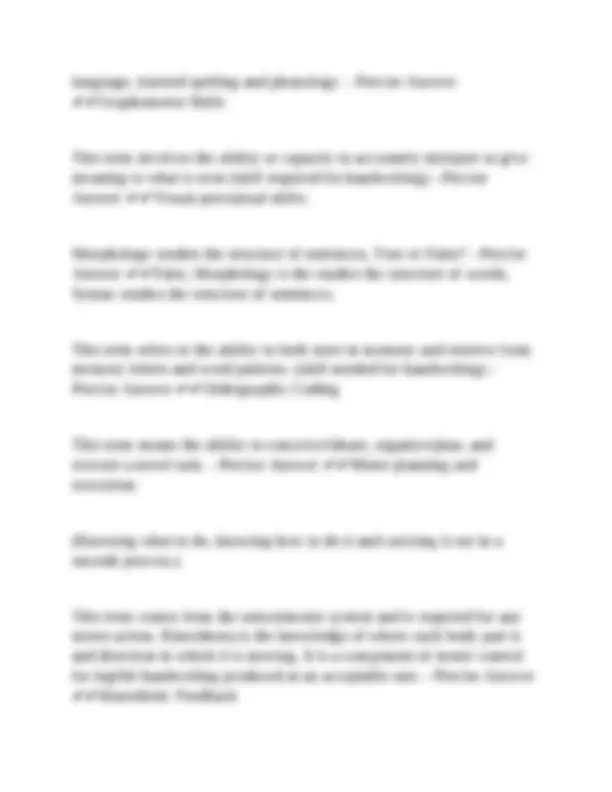
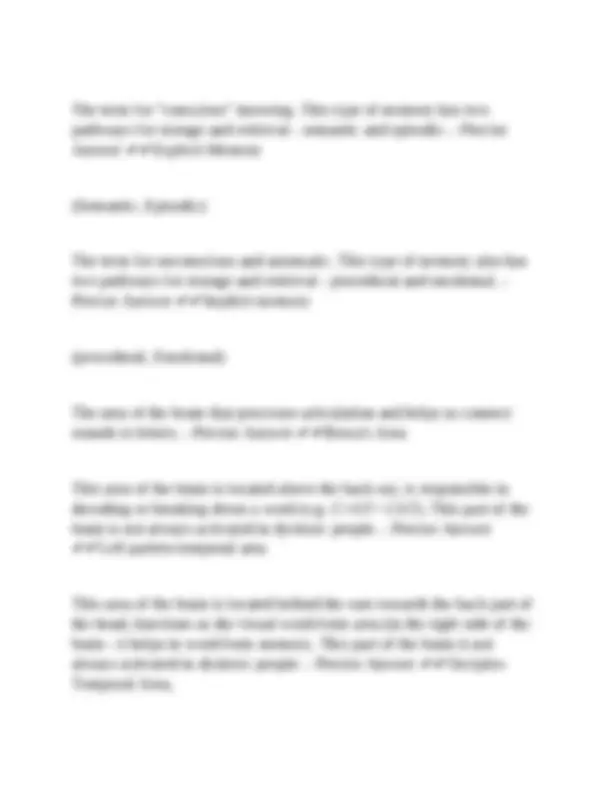
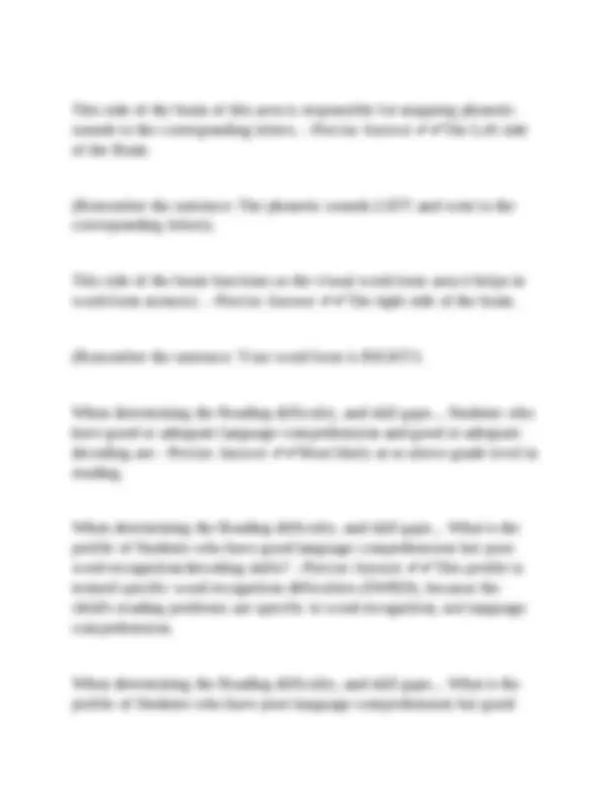
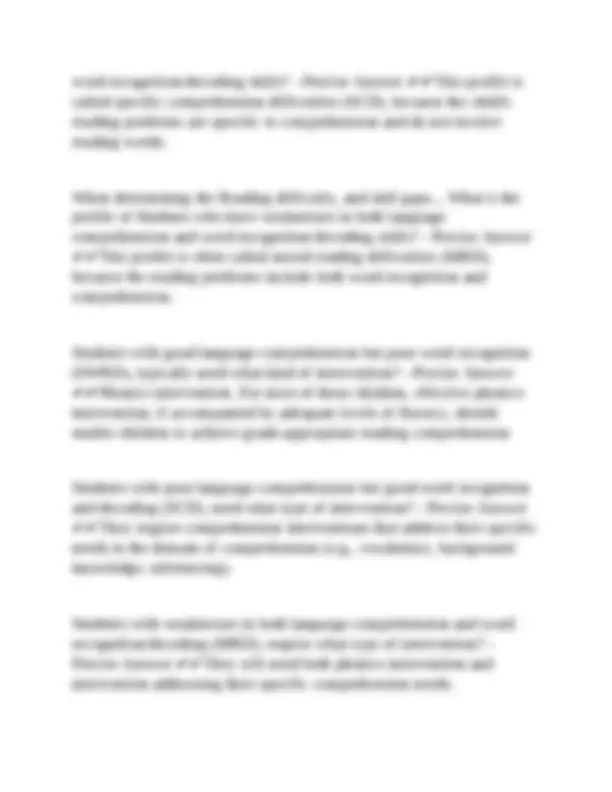
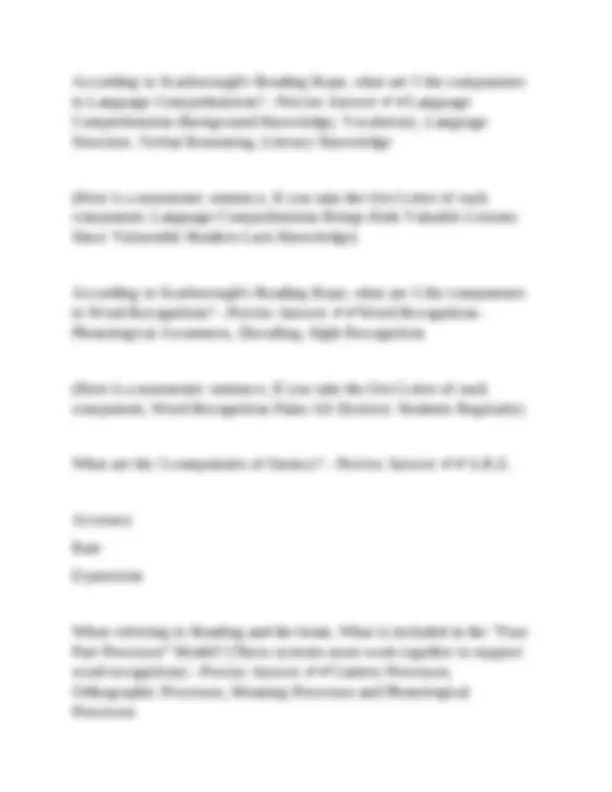
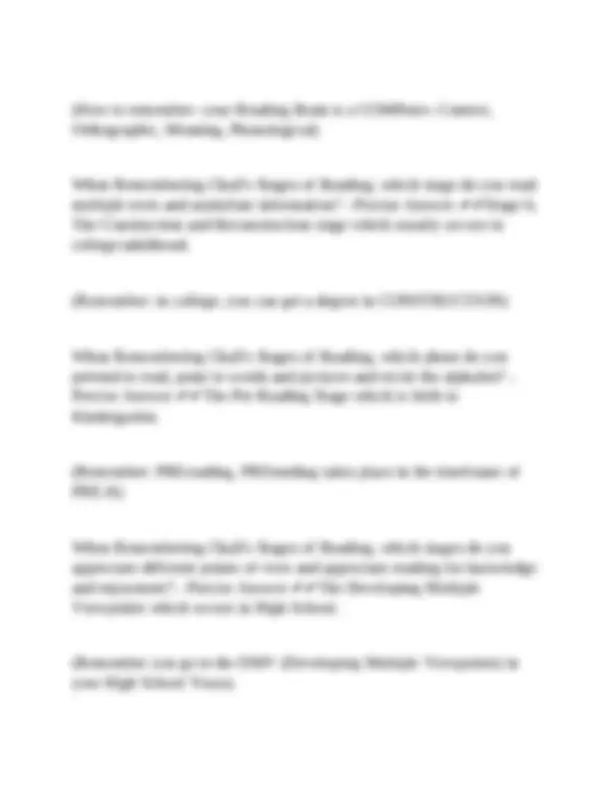
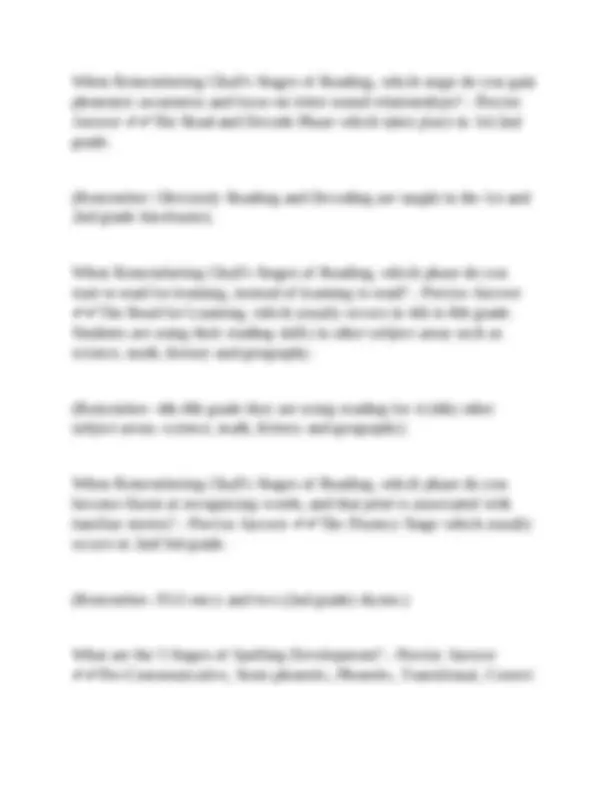
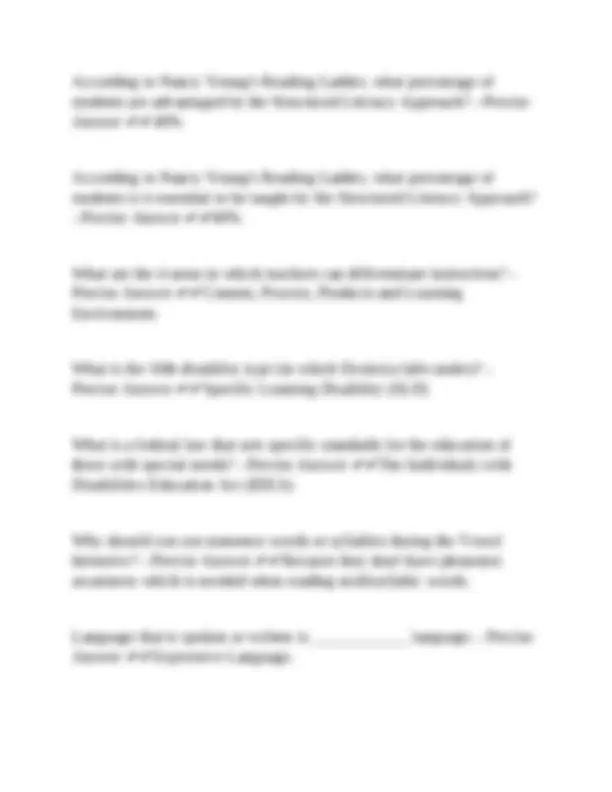
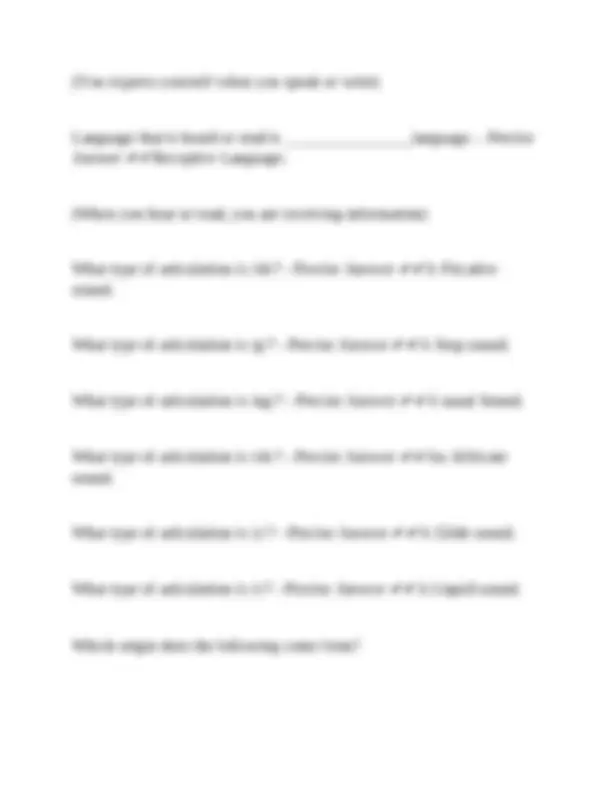
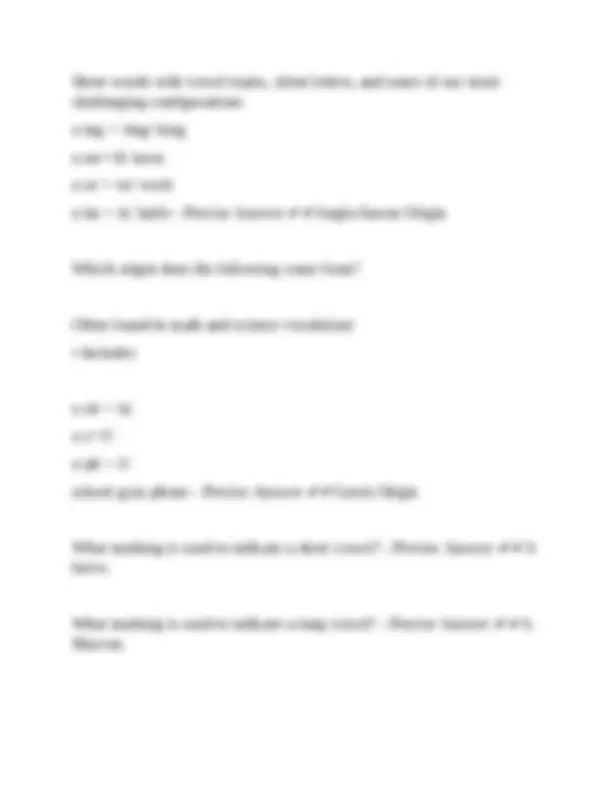
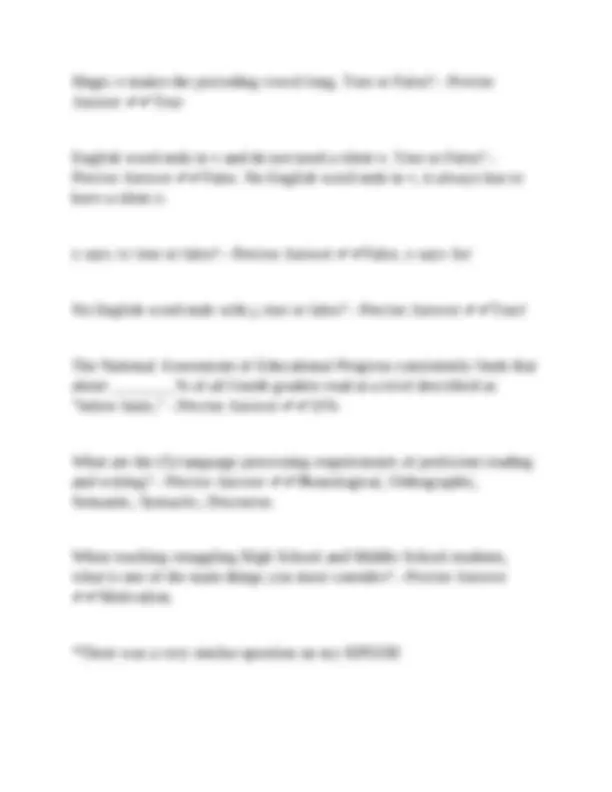
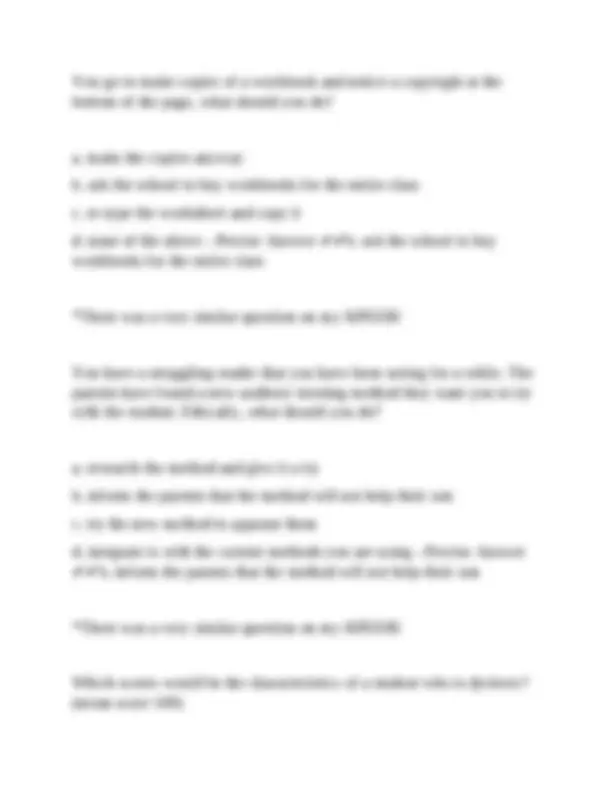
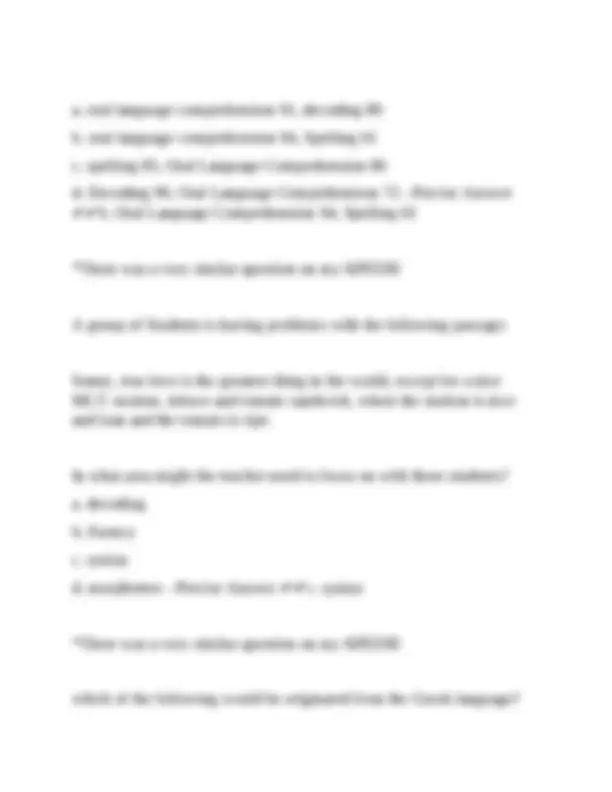
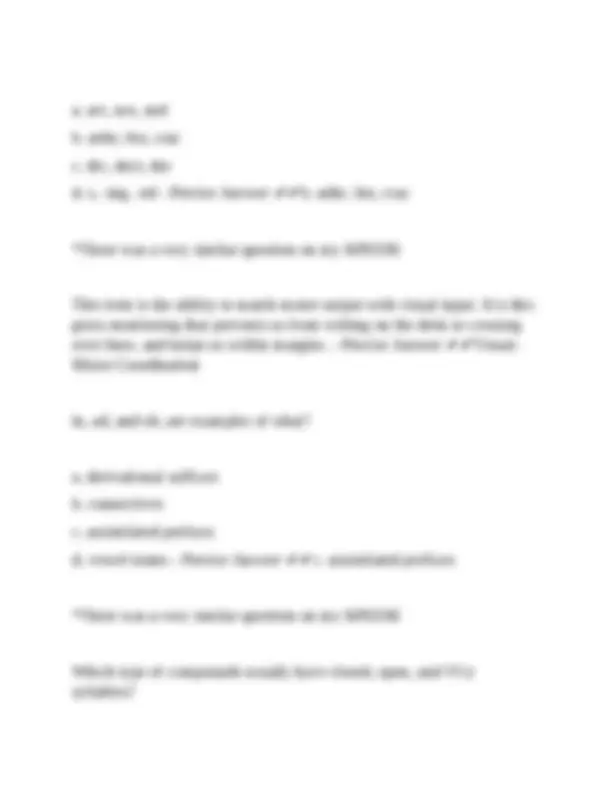
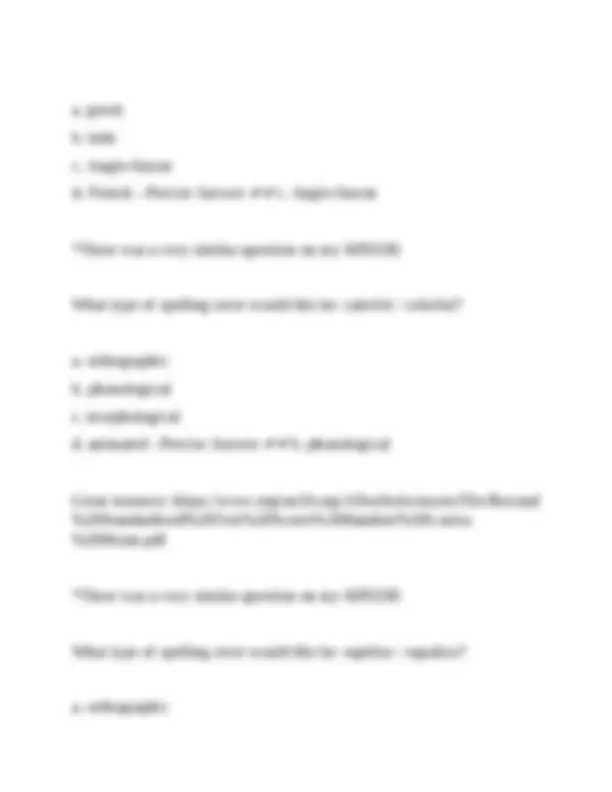
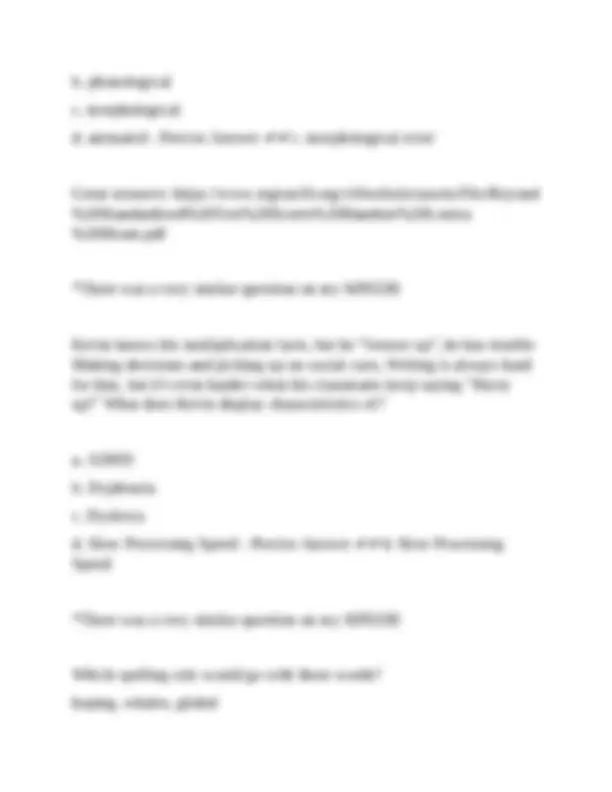
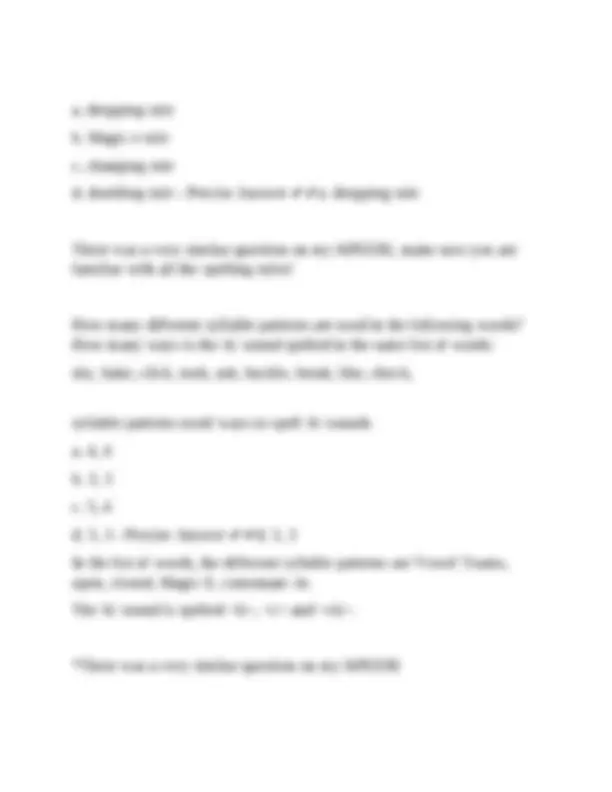
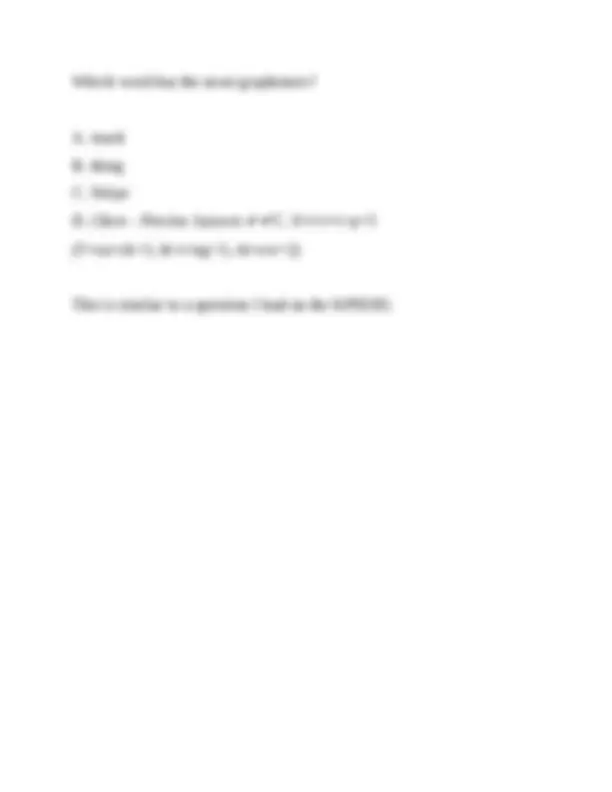


Study with the several resources on Docsity

Earn points by helping other students or get them with a premium plan


Prepare for your exams
Study with the several resources on Docsity

Earn points to download
Earn points by helping other students or get them with a premium plan
Community
Ask the community for help and clear up your study doubts
Discover the best universities in your country according to Docsity users
Free resources
Download our free guides on studying techniques, anxiety management strategies, and thesis advice from Docsity tutors
A comprehensive overview of various linguistic and reading-related concepts, including syllables, consonant blends, consonant digraphs, direct instruction, frustration reading level, general academic words and phrases, guided oral reading, idioms, individualized education programs, morphemic analysis, phoneme isolation, phoneme manipulation, print awareness, regular words, sight words, sound-to-symbol, stop sounds, structural analysis, summarization, syllables, text features, think-alouds, writing vocabulary, vowel digraphs, word roots, and more. The document also covers spelling rules, stages of spelling development, assessment types, and characteristics of students with specific reading difficulties. The level of detail and the range of topics covered suggest that this document could be a valuable resource for students, educators, and researchers in the field of language and literacy education.
Typology: Exams
1 / 75

This page cannot be seen from the preview
Don't miss anything!




































































A word part that contains a vowel or, in spoken language, a vowel sound
introduced before more difficult skills, so that skills build progressively.
A part of writing and preparing presentations concerned chiefly with improving the clarity, organization, concision, and correctness of expression relative to task, purpose, and audience; compared to revising, a smaller-scale activity often associated with surface aspects of a text. - Precise Answer ✔✔Editing A framework used during phonemic awareness instruction. These are sometimes referred to as Sound Boxes. When working with words, the teacher can draw one box per sound for a target word. Students push a marker into one box as they segment each sound in the word. - Precise Answer ✔✔Elkonin Boxes The skills, knowledge, and attitudes that are developmental precursors to conventional forms of reading and writing. - Precise Answer ✔✔Emergent Literacy The ability to translate language into print (writing) is ____________. - Precise Answer ✔✔Encoding (Remember prefix en- means "put into", you are putting sounds into print). Students whose first language is not English and who are in the process of learning English. - Precise Answer ✔✔English Language Learner The origin of a word and the historical development of its meaning is called ________________. - Precise Answer ✔✔Etymology
This type of instruction is step-by-step, and the actions of the teacher are clear, specific, direct, and related to the learning objective. - Precise Answer ✔✔Explicit Instruction (Remember, explicit means something is "expressed clearly") Reports factual information (also referred to as informational text) and the relationships among ideas. This type of text tends to be more difficult for students than narrative text because of the density of long, difficult, and unknown words or word parts. - Precise Answer ✔✔Expository text (Remember, Expository is writing that seeks to EXplain and Inform) Language that is spoken. - Precise Answer ✔✔Expressive Language Language that departs from its literal meaning (e.g., The snow sparkled like diamonds; That child is a handful.). - Precise Answer ✔✔Figurative meanings What are the 5 components of Reading? - Precise Answer ✔✔Phonemic awareness, phonics, fluency, vocabulary, and comprehension. Grouping students according to shared instructional needs and abilities and regrouping as their instructional needs change. Group size and
(Remember, Tier 2 isn't necessarily common in every day language Ex. analyze, restrict, formulate.) The ability to use a learned skill in novel situations. - Precise Answer ✔✔Generalization A letter or letter combination that spells a single phoneme. In English, this may be one, two, three, or four letters, such as e, ei, igh, or eigh. - Precise Answer ✔✔grapheme (Etymology Online- graph= "letter, symbol" + eme ="unit of language structure.") A visual framework or structure for capturing the main points of what is being read, which may include concepts, ideas, events, vocabulary, or generalizations. These allow ideas in text and thinking processes to become external by showing the interrelatedness of ideas, thus facilitating understanding for the reader. - Precise Answer ✔✔Graphic Organizers The relationship between letters and phonemes. - Precise Answer ✔✔Graphophonemic (Examples would include Recognizing alphabetic sequence while singing the alphabet song, naming letters as well as matching upper and lowercase letters).
Instructional support including immediate corrective feedback as students read orally. - Precise Answer ✔✔Guided Oral Reading Students practice newly learned skills with the teacher providing prompts and feedback. - Precise Answer ✔✔Guided Practice Words in print containing letters that stray from the most common sound pronunciation because they do not follow common phonic patterns (e.g., were, was, laugh, been). - Precise Answer ✔✔High Frequency Irregular Words (These are "red words" or "heart words") A small group of words (300-500) that account for a large percentage of the words in print and can be regular or irregular words (i.e., Dolch or Fry). Often, they are referred to as "sight words" since automatic recognition of these words is required for fluent reading. - Precise Answer ✔✔High Frequency Words Words that are spelled the same but have different origins and meanings. They may or may not be pronounced the same (e.g., can as in a metal container/can as in able to). - Precise Answer ✔✔Homograph -same spelling, different meaning and may have a different pronunciation
(Homophones always sound alike, so remember the ending "-phone," which is a Greek root meaning "sound.") Remember the sentence "I am on the PHONE, can you HEAR me in HERE?" Hear- listen Here- location A phrase or expression that differs from the literal meaning of the words; a regional or individual expression with a unique meaning (e.g., it's raining cats and dogs). - Precise Answer ✔✔idiom (If you say something beyond literal meaning, you may sound like an Idiot (idiom).) When an error occurs, the teacher immediately attends to it by scaffolding instruction (i.e., gradual release of responsibility). - Precise Answer ✔✔Immediate Corrective Feedback Instruction that may include more time, more opportunities for student practice, more teacher feedback, smaller group size, and different materials. It is implemented as soon as assessment indicates that students are not making adequate progress in reading. - Precise Answer ✔✔Immediate Intensive Intervention
The opposite of explicit instruction. Students discover skills and concepts instead of being explicitly taught. For example, the teacher writes a list of words on the board that begin with the letter "m" (mud, milk, meal, and mattress) and asks the students how the words are similar. The teacher elicits from the students that the letter "m" stands for the sound you hear at the beginning of the words. - Precise Answer ✔✔Implicit Instruction (Remember the word implied- suggested but not directly expressed) The level at which a reader can read text with 95% accuracy (i.e., no more than one error per 20 words read). - Precise Answer ✔✔Independent Reading Level (Remember 95%) The reading range that spans instructional and independent reading levels or level of text that a student can read with 90% to 95% or above accuracy. - Precise Answer ✔✔Independent-instructional reading level range (Remember 90%-95%) This term refers to students learning the meaning of words indirectly when they hear or see the words used in many different contexts - for example, through conversations with adults, through being read to, and
These routines include the following sequence of steps: Explicit instruction Modeling Guided practice Student practice, application, and feedback Generalization - Precise Answer ✔✔Instructional Routines This is provided only to students who are lagging behind their classmates in the development of critical reading skills. - Precise Answer ✔✔Intervention Instruction Provides content for instruction that is intended for flexible use as part of differentiated instruction and/or more intensive instruction to meet student learning needs in one or more of the specific areas of reading (phonological awareness, phonics, fluency, vocabulary, and comprehension). - Precise Answer ✔✔Intervention Program An attempt to spell a word based on a student's knowledge of the spelling system and how it works (e.g., kt for cat). - Precise Answer ✔✔Invented Spelling A disorder that may affect the comprehension and use of spoken or written language as well as nonverbal language, such as eye contact and tone of speech, in both adults and children. - Precise Answer ✔✔Language Learning Disability
The matching of an oral sound to its corresponding letter or group of letters. - Precise Answer ✔✔Letter-sound correspondence The words needed to understand what is heard. - Precise Answer ✔✔Listening vocabulary A reader cannot understand a text without knowing what most of the words mean. This concept includes reading, writing, and the creative and analytical acts involved in producing and comprehending texts. - Precise Answer ✔✔Literacy Understanding of the basic facts that the student has read. - Precise Answer ✔✔Comprehension An awareness of one's own thinking processes and how they work. The process of consciously thinking about one's learning or reading while actually being engaged in learning or reading. - Precise Answer ✔✔Metacognition This is the smallest meaningful unit of language. This can be one syllable (book) or more than one syllable (seventeen). It can be a whole word or a part of a word such as a prefix or suffix. For example, the word ungrateful contains three of these: un, grate, and ful. - Precise Answer ✔✔Morpheme
morpho=shape/structure phono=sound logy=study of A comparison NOT using like or as. - Precise Answer ✔✔Metaphor (Remember the sentence "He cut a rug when he TAP danced" - meTAPhor) This approach uses visual, auditory, and kinesthetic-tactile cues simultaneously to enhance memory and learning. Links are consistently made between the visual (what we see), auditory (what we hear), and kinesthetic-tactile (what we feel) pathways in learning to read and spell.
Vowels that are pronounced differently from the expected pronunciation (e.g., the "o" in old is pronounced /ō/ instead of the expected /o/. - Precise Answer ✔✔oddities (odd, think different) A part of the word that is the initial consonant sound, blend, or digraph in a single syllable word or syllable. - Precise Answer ✔✔Onset A part of the word that is the first vowel phoneme followed by all the other phonemes (at in rat; esh in fresh). - Precise Answer ✔✔Rime In segmentation in the word swift, sw is the _________ and ift is the _________. - Precise Answer ✔✔onset, rime What are the five components of oral language? - Precise Answer ✔✔phonology, morphology, syntax, semantics, and pragmatics. (Remember: Oral Language gives me bad P.P.M.S.S.) ha ha A child with these difficulties may exhibit poor vocabulary, listening comprehension, or grammatical abilities for his or her age. - Precise Answer ✔✔Oral language difficulties
(Think they are "high Stakes" because their outcome could determine funding for the next year). The Phase of Word-Learning that Sight word learning is at the earliest period. Children do not form letter-sound connections to read words; if they are able to read words at all, they do so by remembering selected visual features. - Precise Answer ✔✔Pre-alphabetic (Think of a child recognizing McDonald's, as they drive by) The Phase of Word-Learning that Children learn the names or sounds of alphabet letters and use these to remember how to read words. However, they form connections between only some of the letters and sounds in words, often only the first and final letter-sounds. - Precise Answer ✔✔Partial alphabetic (Think P = puppy) The Phase of Word-Learning that Children can form complete connections between letters in written words and phonemes in pronunciations. - Precise Answer ✔✔Full alphabetic (Think c+a+t= cat) The Phase of Word-Learning that Readers operate with multi-letter units that may be morphemes, syllables, or subsyllabic units such as onsets and rimes. Common spelling patterns become consolidated into letter
chunks, and these chunks make it easier to read words. - Precise Answer ✔✔Consolidated alphabetic (Think spl+ash= splash) The smallest units of spoken language that makes a difference in the meaning of a word is called a ________________. - Precise Answer ✔✔phoneme In this activity, children make a new word by adding a phoneme to an existing word. (Teacher: What word do you have if you add /s/ to the beginning of park? Children: spark.) - Precise Answer ✔✔Phoneme Addition In this activity, children learn to listen to a sequence of separately spoken phonemes, and then combine the phonemes to form a word. (Teacher: What word is /b/ /i/ /g/? Children: /b/ /i/ /g/ is big. - Precise Answer ✔✔Phoneme Blending In this activity, children recognize the word in a set of three or four words that has the "odd" sound. (Teacher: Which word doesn't belong? bun, bus, rug. Children: Rug does not belong. It doesn't begin with a /b/.)